++++++++++
–
‘Miracle’ as bees survive Notre Dame blaze
Despite the roof of the historic Parisian cathedral being shrouded in flames on Monday, the hives, which were situated on the roof of the building’s first floor, survived without so much as a scratch.
“Thank goodness the flames didn’t touch them,” said beekeeper Nicolas Geant. “It’s a miracle.”
For several days following the fire it was unclear whether or not the hives had been destroyed. It wasn’t until aerial photos were taken that it was possible to confirm that they had survived.
“I was incredibly sad about Notre Dame because it’s such a beautiful building, and as a Catholic it means a lot to me,” said Geant.
“But to hear there is life when it comes to the bees, that’s just wonderful.”
Beekeeping on rooftops is surprisingly common in Paris with several prominent buildings hosting their own hives as part of a concerted effort to help curb the decline in bee populations.
In total there are thought to be at least 700 hives spread across the city.
–
(For the source of this, and many other quite interesting articles, and to watch a video relating to it, please visit: https://www.unexplained-mysteries.com/news/327071/miracle-as-bees-survive-notre-dame-blaze)
++++++++++
Scientists change monkey minds using low-intensity ultrasound
 In a new study, low-intensity ultrasound has been used to disrupt a cognitive process known as counterfactual thinking in macaques monkeys. (Credit: hecke06/Depositphotos).
In a new study, low-intensity ultrasound has been used to disrupt a cognitive process known as counterfactual thinking in macaques monkeys. (Credit: hecke06/Depositphotos). An incredible new study suggests that low-intensity ultrasound can be used to target very specific brain regions and alter an animal’s decision-making processes. The technique, demonstrated in macaques monkeys, prompts actual behavioral changes using non-invasive ultrasound waves.
It is only recently that researchers have begun exploring the effects of low-intensity ultrasound on the brain. Although it is commonly known for its imaging potential, ultrasonic waves can also be highly targeted to modulate brain activity. One exciting human trial is currently underway investigating targeted ultrasound as a potential treatment for Alzheimer’s and dementia, while a fascinating case study published in 2016 demonstrated the technology stimulating the neurons of a young coma patient, essentially “jump-starting” their brain.
“Ultrasound neurostimulation is an early-stage, non-invasive therapeutic technology that has the potential to improve the lives of millions of patients with mental health conditions by stimulating brain tissues with millimeter accuracy,” explains Elsa Fouragnan, from the University of Plymouth and lead scientist on the new study.
The research focused on a cognitive process called counterfactual thinking. This is a part of our decision making processes where we evaluate scenarios that are alternative to our current experience. The researchers give the example of imagining the alternative experience of spending time outside in the sun while working inside the confines of an office.
This specific cognitive process is vital in helping us assess all our available options and choosing the most positive future action. Some scientists hypothesize that psychiatric patients demonstrating repetitive dysfunctional behaviors suffer from irregular counterfactual cognitive processes. The new research set out to home in on where exactly in the brain this cognitive process occurs, and whether targeted low-intensity ultrasound can modulate the process.
“This is a really exciting study for two main reasons – firstly because we discovered that the cingulate cortex is crucial to help switch to better alternatives, and secondly because low-intensity ultrasound can be used to reversibly change brain activity in a very precise part of the brain,” says Fouragnan.
Studying the behavior of four macaques monkeys, the researchers revealed neuronal activity in the anterior cingulate cortex is vital to effective counterfactual thinking. Low-intensity ultrasound was then used to effectively disrupt neuronal activity in that brain region, resulting in the animals displaying different decision-making outcomes.
It’s still very early days for this kind of research, but Fouragnan is hopeful the work can move into human trials very soon.
“Presently, neuromodulation techniques do exist for humans, to help people with conditions such as major depression or Parkinson’s,” he says. “But there are no techniques that have this level of accuracy while remaining non-invasive.”
The new study was published in the journal Nature Neuroscience.
Source: University of Plymouth
[Maybe “They” are already “Altering our thinking”…!]
(For the source of this, and many additional interesting articles, please visit: https://newatlas.com/ultrasound-brain-neuromodulation-decision-making/59314/)
++++++++++
–
RIP to the First Mammal Officially Made Extinct by Climate Change
The tiny creature’s demise has stirred up great controversy.
By Emma Betuel –
Recently, a release from Australia’s Department of the Environment and Energy confirmed the sad fate of the Bramble Cay melomys, a tiny brown rat that is officially extinct, very likely due to climate change. Though the release officially lays the creature to rest, those who have watched its fate over five years have found little peace. Scientists, federal officials, and the local governments are now squabbling over the casket.
The extinction of the Bramble Cay melomys was marked by little fanfare. An announcement about its extinction is tucked away in a release issued by Melissa Price, who serves as Australia’s Minister for the Environment. The release classifies the endangered status of 11 Australian plants and animals, including the Bramble Cay melomys, which was transferred from the “endangered category” to the “extinct category.” It is only mentioned in a reference table at the bottom of the page.
More importantly, despite the fact that climate change has been implicated in the decline, and possible extinction, of the tiny mammal several times in the past, the phrase climate change is completely absent from the release.
Climate Change and the Bramble Cay Melomys
In a 2016 report, scientists at the University of Queensland in Australia noted that the consistent rise in sea level and increases in storm frequency on Bramble Cay — a small, sandy island off the Great Barrier Reef — were the major drivers behind the rat’s dwindling numbers. The conclusion of that report led the state of Queensland’s Department of Environment and Science to confirm the animal’s extinction in 2017. On the state government’s site, the creature is referred to in the past tense, and climate change is implicated in its demise:
Available evidence indicates that the anthropogenic climate change-induced impacts of sea-level rise, coupled with an increased frequency and intensity of weather events that produced damaging storm surges and extreme high water levels, particularly during the last decade, were most likely responsible for the extirpation of the Bramble Cay melomys from Bramble Cay.
The 2016 report sparked international attention. At the time, outlets from the Guardian to National Geographic contemporaneously reported that the melomys was the first mammal to go extinct due to climate change. The federal government of Australia, however, didn’t officially acknowledge the animal’s extinction until Price’s release.
Ignored by the Federal Government
Importantly, the federal release doesn’t make any special note of the role of climate change in the melomys’ unique fate. Instead, it focuses on the pressing and tragic decline of all endangered species in the country but doesn’t go into details about the driver behind those changes. Inverse has reached out to Price regarding these details and will update the article accordingly.
The fact that Australia’s current federal government was late to the game in declaring the extinction of the bramble cay melomys and failed to draw specific attention to the role of climate change in its demise has invited wide condemnation about the government’s attitude toward climate change. Queensland’s Environmental Minister Leeanne Enoch, for one, has criticized the lack of emphasis on climate change in the extinction of the Bramble Cay melomys in Price’s report.
“We have consistently called on [Prime Minister] Scott Morrison and Melissa Price to show leadership on climate change, instead of burying their heads in the sand,” Enoch said, reports The Sydney Morning Herald. “How many more species do we have to lose for the federal government to take action?”
The spokesperson for Australia’s federal Ministry of Environment, Geoff Richardson, told The Sydney Morning Herald that research had been ongoing in the intervening years since the 2016 report, and that the government wanted to make “absolutely certain” before they declared it gone for good. The 2016 report, for its part, mentioned that there could be some melomys individuals on Papua New Guinea, noting that “it may be premature to declare the Bramble Cay melomys extinct on a global scale.”
As of today, however, the message is clear: the Bramble Cay melomys is gone, and maybe has been for years. But while the Australian government has finally officially recognized the loss of the little brown rat, there’s still little emphasis on the sad, human-caused reason that it no longer exists.
Update Wednesday, 10:30 a.m. Eastern: Melissa Price, Australia’s Minister for the Environment told Inverse that the agency declared the Bramble Cay melomys extinct “following exhaustive surveys undertaken in all known habitat leaving no reasonable doubt.”
In regards to the causes of the Bramble Cay melomys’ extinction, she added:
Being confined to a single, very small and isolated location, the Bramble Cay Melomys was particularly susceptible to a wide range of threats. Available evidence indicates that frequent and intense weather events during the decade 2004 to 2014 produced damaging storm surges and extreme high water levels, which were likely significant contributors.
(For the source of this, and many additional interesting articles, please visit: https://www.inverse.com/article/53411-rip-bramble-cay-melomys-the-first-mammal-killed-by-climate-change/)
++++++++++
–
Amphibious, four-legged whale fossil might be a missing link
Whales weren’t always the giants of the sea that we know today – their ancestors plodded around on land before taking to a more aquatic lifestyle. Now a team of palaeontologists has uncovered the fossil bones of a strange new “missing link” whale species, which had four legs and was amphibious.
Named Peregocetus pacificus, the whale species was dated to about 42.6 million years ago, during the middle Eocene epoch. Measuring 4 m (13 ft) long, its four legs, tail and snout make it look more like an otter than a whale.
The creature was clearly just as comfortable on dry land as it was in the water. The team discovered tiny hooves on the tips of its toes – a holdover from its land-dwelling ancestors, which also gave rise to animals like camels and pigs. But they also found clues that indicated those toes were webbed, helping Peregocetus swim. The structures of the vertebrae in its tail, similar to those in beavers and otters, also suggested that its tail played a key role in swimming.
Although Peregocetus isn’t the first four-limbed amphibious whale species to be discovered, it does help plug a big hole in the origin story of whales. It’s long been thought that these amphibious whales originated somewhere around southern Asia more than 50 million years ago, before making their way westward to Africa, then the Americas.
This discovery fits into that narrative nicely. These bones were found in southern Peru, in a coastal desert region named Playa Media Luna, indicating they’d reached South America 42.6 million years ago. After that, it’s believed they migrated up to North America.
“This is the first indisputable record of a quadrupedal whale skeleton for the whole Pacific Ocean, probably the oldest for the Americas, and the most complete outside India and Pakistan,” says Olivier Lambert, corresponding author of the study. “We will keep searching in localities with layers as ancient, and even more ancient, than the ones of Playa Media Luna, so older amphibious cetaceans may be discovered in the future.”
The research was published in the journal Current Biology.
Source: Cell Press via Science Daily
An audio version of this article is available to New Atlas Plus subscribers. More audio articles
(For the source of this, and many other interesting articles, please visit: https://newatlas.com/amphibious-whale-fossil/59169/)
++++++++++
–
The superbug-fighting potential of fish slime
The growing threat of antibiotic-resistant bacteria is seeing scientists get more and more creative in their search for new drugs that might help us maintain the upper hand. Tobacco flowers, rattlesnake venom and Brazilian berries are just a few of the places to turn up exciting new antibiotic candidates of late, and now researchers have uncovered what they say is a potential goldmine of antibiotics in the form of fish slime.
The mucus that coats the surfaces of fish mightn’t seem like a great place to search for life-saving medicines, but this sticky slime plays a vital role in helping fish fend off a host of fungi, bacteria and dangerous pathogens by snaffling microbes before they can do their dirty work.
“Fish mucus is really interesting because the environment the fish live in is complex,” says Molly Austin, an undergraduate chemistry student at Oregon State University and member of the research team. “They are in contact with their environment all the time with many pathogenic viruses.”
That the slime is also known to hold vast amounts of polysaccharides and peptides with antibacterial properties was further impetus for the researchers to explore its antibiotic potential. To do this, they worked with mucus swabbed from juvenile deep-sea and surface dwelling fish caught off the coast of Southern California.
Younger fish were chosen for their underdeveloped immune systems and thicker layers of mucus, in the hope that they would offer a higher abundance of active bacteria. The team isolated and then screened 47 different strains of bacteria, and uncovered a number of new antibiotic candidates.
Five of the extracts strongly repelled the advances of methicillin-resistant S. aureus (MRSA), as did bacteria taken from the mucus of a particular Pacific pink perch. That same bacteria inhibited activity of a colon carcinoma cell line, and three others inhibited the pathogenic fungus Candida albicans.
While all of this is exciting, the researchers aren’t getting too carried away. Before they call jackpot on the antibiotic potential of fish slime, they will seek to determine whether these particular bacteria are a typical and essential part of the animal’s microbiomes, or had simply happened to hop on for a ride at the time of the swabbing.
And this kind of work could have ripple effects beyond simply leading to new drugs that keep humans healthy. Better understanding of fish microbiomes could be of huge assistance to the conservation of marine life, which is under increasing strain from overfishing, plastic pollution, and warming oceans.
The team is presenting the research at the American Chemical Society Spring 2019 National Meeting & Exposition this week.
Source: American Chemical Society
(For the source of this, and many other equally interesting articles, please visit: https://newatlas.com/superbug-potential-fish-slime/59121/)
++++++++++
–
Zebras’ stripes found to keep flies from landing
It was just last month that we heard about a study which indicated that fewer horseflies landed on mannequins with stripes painted onto them. The research was inspired by observations that zebras also tend not to be bothered much by flies. A separate study now offers an explanation as to why that’s the case.
Conducted by scientists from the University of Bristol and the University of California – Davis, the second study involved zebras and domestic horses living at a stable in North Somerset, UK. Utilizing video analysis techniques, it was found that while equal numbers of horseflies circled both types of horses, far fewer actually landed on the zebras.
In order to determine if the stripes were responsible for this difference, the researchers proceeded to cover all of the animals in cloth coats that were either solid white, solid black, or zebra-striped. Sure enough, regardless of whether it was a zebra or a domestic horse wearing the coat, flies landed on the solid colors while largely avoiding the stripes.
It would therefore seem to follow that other variables, such as zebras’ odor or behaviour, weren’t factors in keeping the flies from landing. When flies did land on the zebras, however, the wild horses were more diligent about swishing their tails or running away to get rid of them.
UC Davis wildlife biologist Tim Caro observes zebra behavior in response to biting fly annoyance.
So, what is it that flies don’t like about stripes?
“This reduced ability to land on the zebra’s coat may be due to stripes disrupting the visual system of the horseflies during their final moments of approach,” says U Bristol’s Dr. Martin How. “Stripes may dazzle flies in some way once they are close enough to see them with their low-resolution eyes.”
A paper on the research, which was led by UC Davis’ Prof. Tim Caro, was recently published in the journal PLOS ONE.
Sources: University of Bristol, UC Davis, PLOS via EurekAlert
An audio version of this article is available to New Atlas Plus subscribers.
(For the source of this, and many additional interesting articles, please visit: https://newatlas.com/zebras-horses-flies-stripes/58583/)
++++++++++
–
Woolly Mammoth
Its cells, 28,000 years-old, were reactivated by science.
A team of Japanese and Russian scientists has successfully “reawakened” cells from a 28,000-year-old woolly mammoth, according to a study published recently in Scientific Reports.
The cells came from an extraordinarily well-preserved woolly mammoth discovered in Siberian permafrost in 2012 and nicknamed “Yuka”.
Using a process called nuclear transfer, the scientists took nucleus-like structures from Yuka and implanted them into mouse oocytes, which are highly specialized cells that facilitate embryonic development.
The scientists then used a live-cell imaging technique to observe how the structures reacted in their new environment. They saw traces of biological activity.
“I was looking under the microscope at night while I was alone in the laboratory,” 90-year-old Akira Iritani, a co-author on the new study who’s spent years working toward resurrecting the woolly mammoth, told CNN. “I was so moved when I saw the cells stir. I’d been hoping for this for 20 years.”
https://www.nature.com/articles/s41598-019-40546-1/
(For the source of this, and other equally interesting articles, please visit http://www.BigThink.com).
[T-Rex next…?]
++++++++++
–
Enriched mouse house may make for happier lab mice – and scientists
If you want to study a mouse’s natural behaviour, then perhaps it isn’t best to grab the animal and place it in a setting where it’s required to perform a certain task at a certain time. That’s the thinking behind Autonomouse, a cage that’s designed to make life easier for lab mice, and to produce more accurate results in behavioural studies.
Developed by a team at Britain’s Francis Crick Institute, Autonomouse houses multiple mice living in a social group, who are supplied with running wheels, ladders, and unlimited access to food and water. The system can reportedly run for up to 18 months with only minimal human intervention, although there’s no word on how waste-removal is handled.
All of the mice have uniquely-coded RFID chips inserted under their skin. These are detected by a reader device, that’s able to ascertain factors such as each animal’s current weight, its activity level, and how much water it’s drinking.
Additionally, the chips are used to detect when an individual mouse enters a special “training room.” When this happens, the door to that room is closed behind the mouse, temporarily keeping other mice from entering. The animal is then left to perform a given learning task, which the room is set up for, and which is the object of the study. Behavioural data is automatically recorded, and linked to that specific mouse.
“Working with an unstressed, group-housed cohort of mice that train themselves at the time of day that suits them, without the intervention of researchers over long periods of time, makes our experiments better and more efficient,” says study leader Dr. Andreas Schaefer.
An open-access paper on the research – which includes plans for the Autonomouse system, which other institutes are welcome to use – was recently published in the journal PLOS ONE.
Source: Francis Crick Institute
(For the source of this, and other interesting articles, please visit: https://newatlas.com/autonomouse-lab-mouse-house/58785/)
++++++++++
“Bugpocalypse” Study Reveals What Will Happen if All the Insects Disappear
Forty percent of the world’s insect species could go extinct over the next few decades.
By Stuart Reynolds, The Conversation –
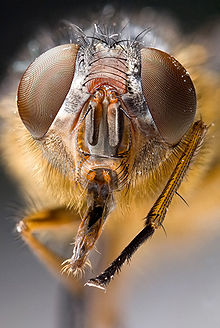
There are an awful lot of insects. It’s hard to say exactly how many because 80 percent haven’t yet been described by taxonomists, but there are probably about 5.5 million species. Put that number together with other kinds of animals with exoskeletons and jointed legs, known collectively as arthropods — this includes mites, spiders, and woodlice — and there are probably about 7 million species in all.
Despite their ubiquity in the animal kingdom, a recent report warned of a “bugpocalypse,” as surveys indicated that insects everywhere are declining at an alarming rate. This could mean the extinction of 40 percent of the world’s insect species over the next few decades.
See also: Humans Are Killing All the Bugs, and It’s Time to Get Worried About It
What is particularly worrying is that we don’t know exactly why populations are declining. Agricultural intensification and pesticides are likely a big part of the problem, but it’s certainly more complicated than that, and habitat loss and climate change could also play a part.
Although some newspaper reports have suggested that insects could “vanish within a century,” total loss is unlikely — it’s probable that if some species die out, others will move in and take their place. Nevertheless, this loss of diversity could have catastrophic consequences of its own. Insects are ecologically important, and if they were to disappear, the consequences for agriculture and wildlife would be dire.

The Sprawling Kingdom of Bugs
It’s difficult to overstate how many species there are. Indeed, the 7 million estimate above is likely a major underestimate. Lots of insects that look alike — so-called “cryptic species” — are distinguishable only by their DNA. There are an average of six cryptic species for every easily recognizable kind, so if we apply this to the original figure, the potential total number of arthropods balloons to 41 million.
Even then, each species has multiple kinds of parasites which are mostly specific to just one host species. Many of these parasites are mites which are themselves arthropods. Conservatively allowing just one kind of parasitic mite per host species brings us to a potential total of 82 million arthropods. Compared with only around 600,000 vertebrates — animals with backbones — that’s 137 species of arthropod for every vertebrate species.
Astronomical numbers like these caused the physicist-turned-biologist Sir Robert May to observe that “To a good approximation, all [animal] species are insects.” May was good at guessing big numbers — he became the UK Government’s chief scientist — and his quip in 1986 now seems pretty close to the mark.
That’s just diversity, though. How many individual insects would be lost in a mass extinction? And how much might they weigh? Their ecological importance will likely depend on both measures. It turns out that insects are so numerous that even though they are small, collectively, their weight far outstrips that of the vertebrates.
Perhaps the most celebrated ecologist of his generation, the Harvard ant enthusiast E.O. Wilson estimated that each hectare (2.5 acres) of Amazonian rainforest is inhabited by only a few dozen birds and mammals but well over 1 billion invertebrates, almost all of which are arthropods.
That hectare would contain about 200kg dry weight of animal tissue, 93 percent of which would be made up of invertebrate bodies, and a third of that being just ants and termites. This is uncomfortable news for our vertebrate-centric view of the natural world.

The Wriggling Foundations of Life
The role allotted to all these tiny creatures in the grand scheme of nature is to eat and be eaten. Insects are the key components of essentially every terrestrial food web. Herbivorous insects, which make up the majority, eat plants, using the chemical energy plants derive from sunlight to synthesize animal tissues and organs. The job is a big one, and is split into many different callings.
Caterpillars and grasshoppers chew plant leaves, aphids, and plant hoppers suck their juices, bees steal their pollen and drink their nectar, while beetles and flies eat their fruits and devastate their roots. Even the wood of huge trees is eaten by wood-boring insect larvae.
In turn, these plant-eating insects are themselves eaten, being captured, killed, or parasitized by yet more insects. All of these are, in their turn, consumed by still larger creatures. Even when plants die and are turned to mush by fungi and bacteria, there are insects that specialize in eating them.
Going up the food chain, each animal is less and less fussy about what kind of food it will eat. While a typical herbivorous insect might consume only one species of plant, insectivorous animals (mostly arthropods, but also many birds and mammals) don’t much care about what kind of insect they catch. This is why there are so many more kinds of insect than birds or mammals.
Because only a small fraction of the material of one kind of organism is transformed into that of its predators, each successive stage in the food chain contains less and less living matter. Even though efficiency in this process is known to be greater higher up the food chain, the animals “at the top” represent only a few percent of the total biomass. This is why big, fierce animals are rare.
See also: Crops Already Ravaged by Climate Change Face a New Threat: Hungrier Bugs
And so it’s obvious that when insect numbers decrease, everything higher up in the food web will suffer. This is already happening — falling insect abundance in Central American tropical forest has been accompanied by parallel declines in the numbers of insect-eating frogs, lizards, and birds. We humans ought to be more careful about our relationship with the little creatures that run the world. As Wilson commented:
“The truth is that we need invertebrates, but they don’t need us.”
Knowing about insects and their ways is not a luxury. Wilson’s friend and sometime colleague Thomas Eisner said:
“Bugs are not going to inherit the Earth. They own it now.”
If we dispossess them, can we manage the planet without them?
This article was originally published on The Conversation by Stuart Reynolds. Read the original article here.
++++++++++
–
3 Itsy Bitsy Reasons Spiders Aren’t Out to Get You
Don’t believe the web of lies.
By Gerhard J. Gries and Andreas Fischer –

It’s early in the morning. The buzzer goes off, you switch on the light, and immediately panic: a large spider sits on your bedroom wall!
Many people suffer from arachnophobia, which is the fear of spiders. Their arachnophobic responses range from subtle discomfort to fumigating their homes. Yet, they have no reason to be afraid of spiders. They just don’t know them well enough. Luckily, fact-based education of arachnophobes helps alleviate their extreme and irrational fear of spiders and enables them to live a less stressful and fearful life.
See also: Spiders Can Fly and They Don’t Even Need Wings, Study Claims
Education about spiders dispels fear, avoids misconceptions, and instills a sense of appreciation and wonder. Spiders are among the most fascinating and diverse creatures on Earth.
The Roots of Arachnophobia
No one knows the origin of this widespread arachnophobia. With respect to evolution, this phenomenon does not make immediate sense. Avoidance behavior to a perceived threat might have evolved if that threat were to be persistent. But spiders do not pose such persistent threats to humans. This is puzzling to scientists.
There are only a few spiders that could possibly harm us. Most spiders are physically not even able to cause any harm. They are unable to puncture our skin or their venom does not irritate our body tissue.
In Canada, black widow spiders have neurotoxins and can pierce through our skin, but they are not really dangerous to healthy adults (though children and the elderly would need to be watched). Black widows are not aggressive. For them to bite a person, you have to virtually squeeze them. The non-aggressiveness of most spiders, even the venomous ones, effectively renders them harmless.
Ill-Reputed Spiders
Fake news about spiders dominate folklore and spread through the internet. For example, the bites of brown recluse spiders can cause necrosis, but it is their harmless cousins, the hobo spiders, that live in Canada. Similarly, false black widows — who look like black widows but are harmless — often find their way into our homes but are less likely to bite us than bees are to sting us when they accidentally fly into our homes.
Unfortunately, many alleged spider bites are misdiagnosed, and the bite symptoms were actually inflicted by other critters or microbes. Such misdiagnoses may even become health-threatening when they prompt inappropriate treatment(s) of the patient. For this reason alone, it is always helpful to capture the alleged biter so that it can be identified, and the patient be treated accordingly.
When encountering a spider at home, many people opt for spraying it with pesticide. But pesticides have long-lasting residual activity, adversely affecting us, our children, and pets. Strategically placed sticky traps (e.g. behind appliances) are a safe alternative to remove spiders and other unwanted creepy crawlies from our homes.
Spiders’ Place in the Ecosystems
By capturing countless insects, spiders play key roles in ecosystems and in agricultural and forestry settings. It is the friendly neighborhood spider that helps protect our crops from insect herbivores. Once we open our eyes to the world of spiders, we will be amazed instead of disgusted and be fascinated instead of fearful. A few stories may serve as examples.
Males of the nursery web spider offer bridal gifts to their future mates. While the female is enjoying her snack, he strives to mate with her before she finishes eating and before she wants him for “dessert.”
The phenomenal jumping ability when they pounce on prey “inspidered” the moniker jumping spiders and is only one reason why they are so fascinating. Entertainingly colorful, extremely photogenic, but no bigger than a thumbnail, the males of some jumping spiders put on a dance-off with remarkable moves to impress females. Jumping spiders use hydraulic pressure to extend their legs, and from a standstill can leap distances up to six times their body length. We humans have to contend with a standstill leaping distance of merely 1.5 times our body length. And just for the record, humans did not invent the hydraulics in our engines; we merely copied the spiders’ invention.
The tiny Darwin’s bark spider is another Guinness record holder. It builds beautiful 25 m wide(!) orb-webs across rivers. Its silk is one of the toughest natural materials known. If we were to weave it into T-shirts, they would be bullet-proof.
See also: Terrifying Dinosaur-Age Fossils Resemble Fanged Spiders With Tails
Spiders are diverse in shape and behavior. Some spiders build webs which they never leave, while others walk around to hunt, or dig tunnels within which they await prey passing by. Spiders weave many different types of webs, each serving a specific purpose. Other spiders won’t simply wait for prey, they attract it. Bolas spiders produce the female sex pheromone of some moths. This pheromone then attracts male moths that fly towards the spider in anticipation to find a moth mate. When the female spider hears the male moth approaching, she swings her sticky bola and snares him out of the air. The mosquito-terminator spider, on the other hand, spares no efforts to hunt down mosquitoes that have recently fed on blood.
Spiders may be more afraid of us than we are of them: They are not aggressive and would rather be left alone. If we consider the many things we can learn about and from spiders, our fear of them will turn into fascination for spiders.
This article was originally published on The Conversation by Gerhard J. Gries and Andreas Fischer. Read the original article here.
(For the source of this, and other interesting articles, please visit: https://www.inverse.com/article/53322-why-you-shouldn-t-be-afraid-of-spiders/)
++++++++++
“Zombie deer disease,” a mad cow-like infection spreading in the US, explained
A mad cow-like infectious disease that can turn the brains of deer, elk, and moose into “Swiss cheese.”
++++++++++
–
In Controversial Study, Tiny Fish Appears as Self-Aware as Chimps, Dolphins
Some scientists refuse to accept it.
By Peter Hess –
Controversial new research shows that a tiny, unsuspecting species of fish can pass a test that’s widely considered the gold standard of intelligence. As far as we can tell, only a few of the most intelligent non-human animals pass this mirror self-recognition test: great apes (gorillas, chimpanzees, bonobos, and orangutans), bottlenose dolphins, and Asian elephants, and a handful of others. In light of the unexpected new findings, some researchers are arguing it’s time for scientists to rethink how they test animal intelligence.
In a paper recently published in the journal PLOS Biology, an international team of researchers led by Masanori Kohda, Ph.D., a professor specializing in fish behavior at Osaka City University, outlines how the cleaner wrasse (Labroides dimidiatus) shows signs of self-recognition while looking in a mirror. In doing so, the fish, known for its ability to live off of the parasites it cleans off of other fish, appears to pass the test for “mirror self-recognition” — long considered a hallmark of self-awareness in animals.
Whether it means the cleaner wrasse is self-aware — or that this is a really bad test of self-awareness — is now up for debate.
When researchers uncovered mirrors in the fishes’ tanks, seven out of 10 of the fish in the study attacked it, meaning they probably viewed their reflections as rivals. But over the course of a week, they attacked the mirror less and less often and eventually stopped almost entirely. As this behavior died down, another took its place: The wrasses began swimming upside-down, which has never been observed before in either solo wrasses or groups. The fish, it seemed, were inspecting their reflections in a new way.
Things got even more interesting when the researchers put a mark on the fishes’ throats that they could only see in the mirror.
Rather than biting at the reflection, as a cleaner wrasse would when cleaning another fish (a move that would mean the fish failed the test), the fish appeared to try to scrape the mark off themselves by diving to the bottom of the tank and scraping their own throats on the aquarium pebbles. When the researchers used a transparent mark, or removed the mirror, the first didn’t seem to notice it, suggesting that seeing the mark in the mirror was the cue that led the fish to try to clean themselves.
The results have sparked controversy among the scientific community. Some researchers view the mirror test as an “all-or-nothing” measure that doesn’t account for subtle differences in animal cognition and behavior. Just because the fish look like they’re self-aware, they argue, doesn’t mean they have a clear sense of “self” in the same way that humans do.
“Complex cognitive capacities evolve bottom-up in small incremental steps from more basic traits shared across a wide range of species,” writes Frans de Waal, Ph.D., a professor of primate behavior at Emory University, in an accompanying editorial commissioned by PLOS to address the debate. “Therefore, we do not expect all-or-nothing cognitive differences between related species. Yet, for the capacity of self-awareness, we still live with a ‘Big Bang’ theory, according to which this trait appeared out of the blue in just a handful of species, whereas the vast majority lacks it.”
While the test may be an imperfect way to measure self-awareness, the results nonetheless indicate that cleaner wrasses, well known for being intelligent, are exhibiting some kind of behavior that merits further study.
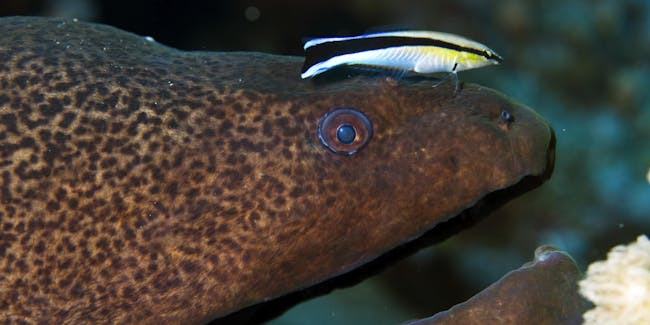
The cleaner wrasse is so helpful that larger species let it be instead of eating it.
The study’s authors explain that the mirror self-recognition test involves three phases before the animal is marked in a place it can’t see without a mirror: “(i) social reactions towards the reflection, (ii) repeated idiosyncratic behaviours towards the mirror, and (iii) frequent observation of their reflection.” And as described in the paper, the fish engaged in all these behaviors.
What de Waal argues is that it’s not clear that the fish are really trying to clean themselves because of what they saw in the mirror. Perhaps they are just cleaning themselves reflexively after seeing what they think is another individual with a skin parasite. After all, the scraping behavior isn’t a new behavior.
“True, self-scraping is not a behavior one would expect if these fish interpret their reflection as another individual, but is this enough reason to conclude that they perceive the fish in the mirror as themselves?” he writes. “After all, the most compelling evidence for the latter would be unique behavior never seen without a mirror, whereas self-scraping, or glancing, is a fixed action pattern of many fish. We may need an in-depth study of this particular pattern before we can ascertain what it means when performed in front of a mirror.”
A major part of this problem is that the tests that can be performed on a fish are fairly limited. Unlike an elephant’s trunk or a chimpanzee’s fingers, the wrasse doesn’t have an appendage that it uses to explore its own body. Therefore, scientists can only infer why the fish is scraping the rock in the aquarium, whereas a chimp inspecting its body, for instance, is pretty clear sign that it understands it’s looking at itself in a mirror.
So is the cleaner wrasse as smart as a dolphin? For now, it’s hard to say. But it’s clear that scientists need to figure out a new way to assess animal intelligence.
(For the source of this article, and to watch a video relating to it, please visit: https://www.inverse.com/article/53117-is-a-cleaner-wrasse-self-aware/)
++++++++++
Microplastics discovered in the guts of sea turtles all over the world
There remains a lot we don’t know about the whereabouts of the all the plastic waste that washes into the ocean each year, but scientists are continuing to discover bits and pieces in increasingly concerning places. The latest study in this area has uncovered evidence of plastic waste in the stomachs of sea turtles hailing from all corners of the globe, shedding new light on the far-reaching implications of our plastic pollution problem.
The trouble with the millions of metric tons of plastic waste that make their way into the sea each year (aside from the obvious) is the fact that much of it is broken down by ocean forces into tiny fragments called microplastics. Though there are advanced distribution maps and other tracking tools in development, we currently have no way of knowing where most of it ends up.
But there are some undesirable places we know microplastics do exist, and the list keeps on growing. This year alone scientists have found various microplastics in human stools all over the world and packed into Arctic sea ice in huge abundance. They also discovered them in 93 percent of bottled water.
The concern is that we don’t really know what effect the ingestion of plastics can have on living creatures, because our understanding of the reactions between its chemicals and those organisms is very limited. To that end, the World Health Organization launched a health review earlier this year to try and fill the gaps.
Which brings us to the turtles. Researchers from the University of Exeter and Plymouth Marine Laboratory carried out autopsies on 102 turtles from the Pacific, Mediterranean and the Atlantic oceans, covering all seven species. They found microplastics in every single one, with the most common type being the fibers uses in clothes, cigarette filters and fishing nets.
“Their small size means they can pass through the gut without causing a blockage, as is frequently reported with larger plastic fragments,” said lead author Dr Emily Duncan from the University of Exeter. “However, future work should focus on whether microplastics may be affecting aquatic organisms more subtly. For example, they may possibly carry contaminants, bacteria or viruses, or they may affect the turtle at a cellular or subcellular level. This requires further investigation.”
The research was published in the journal Global Change Biology.
Source: University of Exeter
(For the source of this, and many other important articles, please visit: https://newatlas.com/microplastic-guts-sea-turtles/57649/)
++++++++++
Divers encounter 26-foot deep-sea worm in New Zealand

Two divers encountered a 26ft long deep-sea worm off the coast of Whakaari in New Zealand.
The creature is thought to be a Pyrosome, a huge hollow colony made up of thousands of individual organisms.
Diver Andrew Buttle, 48, said: “Having never seen one in person or even footage or photos of one before, I was quite incredulous and elated that such a creature existed.
“It was very puzzling but also fantastic to be able to view it right up close and spend so much time with it.
“The island is 48 kilometres from the mainland, and there is a vast amount of fish life and nutrients in the water that may have had the right circumstances to become so large.”
From Wikipedia, the free encyclopedia:
Pyrosomes, genus Pyrosoma, are free-floating colonial tunicates that live usually in the upper layers of the open ocean in warm seas, although some may be found at greater depths. Pyrosomes are cylindrical or cone-shaped colonies made up of hundreds to thousands of individuals, known as zooids. Colonies range in size from less than one centimeter to several metres in length. They are commonly called “sea pickles”.
In 2017, pyrosomes were observed to have spread in unprecedented numbers along the Pacific coast of North America as far north as Alaska. The causes remain unknown, but one hypothesis is that this bloom may have resulted in part from unusually warm water along the coast over several preceding years. Scientists were concerned that should there be a massive die-off of the pyrosomes, it could create a huge dead zone as the decomposition of their bodies consumed much of the oxygen dissolved in the surrounding seawater.
(For the source of this article, and to watch a video about it, please visit: https://www.telegraph.co.uk/news/2018/12/07/divers-encounter-26-foot-deep-sea-worm-new-zealand/amp/)
++++++++++
++++++++++
The mystery of how, and why, wombats produce cubic poop
Wombat poo has mystified scientists for years. The shy Australian marsupial is unique for being the only animal in the world to produce cubic poo. A team of researchers has finally uncovered exactly how this quiet animal produces its square feces, and the discovery could lead to novel manufacturing techniques.
Poo comes in a variety of shapes, however the cubed dung of wombats is unique in the animal kingdom. Scientists have long wondered how this freakish feces is created. We can say for sure it is not because the animal’s have square anuses, but apart from that this has remained quite the odd biological mystery.
“The first thing that drove me to this is that I have never seen anything this weird in biology. That was a mystery,” says Patricia Yang, a mechanical engineer from Georgia Institute of Technology, who became fascinated with how this oddly-shaped poop was created. “I didn’t even believe it was true at the beginning. I Googled it and saw a lot about cube-shaped wombat poop, but I was skeptical.”
Yang and colleagues joined forces with an Australian biologist from the University of Tasmania to try and solve this mystery. The researchers obtained two dissected intestinal tracks from wombats that had been euthanized after suffering injuries from motor vehicle accidents.
Wombats have an extraordinarily slow digestive process. It can take anywhere from eight to eighteen days for food to completely pass through its very long digestive system, however the new research revealed that the cubic shape of its dung isn’t formed until it reaches the final parts of the intestine. The feces stays in a relatively liquid state until it reaches the final 8 percent of the intestine where it begins to shape into small cubes.
“This shape change was due to the azimuthally varying elastic properties of the intestinal wall,” the researchers write in an abstract, recently presented at the Annual Meeting of the APS [American Physical Society] Division of Fluid Dynamics. “By emptying the intestine and inflating it with a long balloon, we found that the local strain varies from 20 percent at the cube’s corners to 75 percent at its edges. Thus, the intestine stretches preferentially at the walls to facilitate cube formation.”
Of course it isn’t unreasonable to be wondering why these animals evolved such a sophisticated way to produce cubed poo, when no other animal in the world found the need to do the same. Wombats have notoriously bad eyesight, so they communicate using scent markings. The animal’s poo frequently acts as territorial markers letting other wombats know who runs a given burrow.
It is hypothesized that because of the importance of poo as a communicative tool, the animal evolved the cube-shaped excretion as a way to efficiently pile up structures of droppings. After all, you couldn’t exactly build a large pile out of round droppings as effectively as you could if it were square blocks.
The new research is not just an academic scat investigation either, it may also render quite the pragmatic outcome. Yang suggests that this method could be applied to our current manufacturing processes.
“We currently have only two methods to manufacture cubes: We mold it, or we cut it. Now we have this third method,” says Yang. “It would be a cool method to apply to the manufacturing process — how to make a cube with soft tissue instead of just molding it.”
The new research was presented at the 71st Annual Meeting of the APS Division of Fluid Dynamics.
Source: SciMex
An audio version of this article is available to New Atlas Plus subscribers.
(For the source of this, and other equally interesting articles, please visit: https://newatlas.com/wombat-square-poo-study/57289/)
++++++++++
WWF report reveals a 60% decline in wildlife populations since 1970

The World Wildlife Fund (WWF) has released its latest Living Planet Report, an assessment of the health of our planet, and it paints a rather grim picture of the damage caused by humanity’s growing footprint on Earth.
The WWF publishes its Living Planet Report every two years, and the last edition in 2016 described a sharp decline in global animal populations, with the number of vertebrates falling by well over half between 1970 and 2012. It warned that if no action was taken, this would result in some 67 percent of all animals disappearing by 2020. [!]
Humanity’s need for food and energy were noted as the most damaging factors, and two years on the reading doesn’t get any better. The demand we place on the planet’s natural resources to fuel our lifestyles continues to take a huge toll on biodiversity around the world. So much so, the WWF now says we’ve seen an average 60 percent decline in mammal, bird, fish, reptile and amphibian populations between 1970 and 2014, the year that data was last available.
This figure is based on the WWF’s Living Planet Index, which tracks global diversity by monitoring 16,704 different populations of more than 4,000 vertebrate species around the world.
Habitat loss and degradation, along with behaviors like overfishing and overhunting, are listed as the top threats to animal species. The report also states that Earth has lost an estimated 50 percent of its shallow water corals in the last 30 years, along with a startling 20 percent of the Amazon.
“This report sounds a warning shot across our bow,” says Carter Roberts, president and CEO of WWF-US. “Natural systems essential to our survival – forests, oceans, and rivers – remain in decline. Wildlife around the world continue to dwindle. It reminds us we need to change course. It’s time to balance our consumption with the needs of nature, and to protect the only planet that is our home.”
(For the balance of this article please visit: https://newatlas.com/wwf-report-60-percent-decline/57014/)
++++++++++
Thrilling natural wonders in the 54th Wildlife Photographer of the Year Awards

In its 54th year, the Wildlife Photographer of the Year competition is the world’s longest running nature photography competition. This year’s winning image, an extraordinary picture of two golden snub-nosed monkeys in central China, affirms this competition’s place as one of the most spectacular annual celebrations of nature.
The competition was originally started by BBC Wildlife Magazine in 1965, and in 1984 the Natural History Museum came on board to help make it the massively impressive event that it is today. The competition is divided between Adult and Youth sections, with 16 Adult categories ranging from Animal Portraits to Urban Wildlife.

The big award is the Photographer of the Year, with a £10,000 (US$13,000) prize. This year’s top award went to Dutch photographer Marsel van Oosten, with an image titled The Golden Couple. Captured in China’s Qinling Mountains, the gorgeous photograph immortalizes a pair of endangered golden snub-nosed monkeys, of which a population of only around 22,000 remain.
‘This image is in one sense traditional – a portrait,” says Chair of the judging panel, Roz Kidman Cox. “But what a striking one, and what magical animals. It is a symbolic reminder of the beauty of nature and how impoverished we are becoming as nature is diminished. It is an artwork worthy of hanging in any gallery in the world.”
The overall Young Wildlife Photographer of the Year winning image (seen above) is just as sublime. From 16 year old South African photographer, Skye Meaker, it is a captivating shot of a leopard waking from a nap in Botswana. Judge Alexander Badyaev, comments on Meaker’s winning image, “With precisely executed timing and composition, we get a coveted glimpse into the inner world of one of the most frequently photographed, yet rarely truly seen, animals.”

Other incredible winning shots, selected from more than 45,000 entries, include a spectacular overhead shot of crabeater seals resting on an ice floe (above), a heart-wrenching image of a female mountain gorilla mourning her deceased baby, and a remarkable look at the mud-handling skills of mud-dauber wasps.
London-based readers can check out all 99 of the top photographs in this year’s competition right now at the Natural History Museum. Entries for next year’s competition opened on October 22.
Take a look through our gallery at some more incredible highlights from this remarkable competition.
Source: Wildlife Photographer of the Year
(For the source of this article, plus additional photos, please visit: https://newatlas.com/wildlife-photographer-award-2018-gallery/56838/)
++++++++++
Moose Cavalry
Moose cavalry are military units of cavalrymen mounted on moose (Eurasian elk, Alces alces alces) rather than the more usual horses. There are legends that state that the Mansi people of Western Siberia rode moose into battle but there is no evidence of this. In 17th-century Sweden Charles XI trialled the use of moose as a replacement for horses, which had to be imported. However they proved susceptible to disease, hard to feed and fearful of the sound of gunfire. The use of moose cavalry by the Soviets in the Winter War of 1939 and 1940 is also reported but seems to stem from a 2010 Popular Mechanics April Fools’ Day article.
Russia
Legends state that the Mansi people of Western Siberia rode into battle mounted on moose. The antlers of the animals are said to have been painted red. No evidence of such use has been found. In the 18th-century Catherine the Great is said to have outlawed the domestication of the moose out of fear that dissidents exiled to Siberia might use them as mounts in any armed rebellion against her. The story is believed to be apocryphal.
Sweden
The moose (Eurasian elk, Alces alces alces) had been used in Sweden to draw the sleighs of the Royal couriers since at least the reign of Charles IX. They proved effective in this role, able to travel around 230 miles in a day. As a development of this role Charles XI (1660 – 1697) trialled the use of moose cavalry. The intention was to replace the horses of one of his cavalry regiments with moose, to avoid the need to import horses as was the contemporary practice. It was anticipated that the animals would cause fear in the horses of enemy cavalry, allowing formations to be broken without the need for artillery or musketry. The idea was presented to the Royal Swedish Academy of Sciences in Stockholm.
During training it was found that the moose was too fearful an animal to allow itself to be ridden into battle, taking fright at the sound of gunfire. They were also said to be of too peaceful a nature for the purpose. Moose were also more susceptible to disease than horses and there was difficulty in feeding the animals which were used to foraging across large areas rather than being fed on fodder in pasture.
April Fools’ Day hoax
It has been claimed by various sources that Joseph Stalin attempted to introduce the moose as a replacement for horses in Soviet cavalry regiments based in the northern parts of the country during the 1930s. The story is thought to have been popularised by a 2010 April Fools’ Day article published in the Russian language edition of Popular Mechanics.
The article made the claim that 1,500 moose cavalrymen had been trained for service in the 1939-40 Winter War. It was stated that machine guns were mounted to the antlers of the moose. Among the more outlandish claims made was that the start of the war was postponed to avoid clashing with the moose mating season and that the animals could distinguish between the Russian and Finnish languages spoken at a distance of over a kilometre. The article included several photographs supposedly showing members of the moose cavalry unit. These were in fact posed by members of Popular Mechanic’s publishing house dressed in reproduction Red Army uniforms with the moose superimposed in post-processing. A graphics artist, Vitas Chernyauskas, mocked-up the front cover of an instruction manual for the unit, based on contemporary Soviet documents and this was also included in the article.
The hoax article was widely reproduced in Russian media over the following years, often without the April Fools’ Day disclaimer carried in the original article. Posters on military history forums often claimed to have seen, or even read, copies of the fictional instruction manual. The coverage in newspapers, satirical sites and social media meant that the story gained a measure of credence as a historical fact. Moose were later successfully domesticated in Soviet Russia but as livestock, for their milk and antlers.
In 2017, a war museum in Lakhdenpokhya, Karelia, Russia showcased the doctored photographs from the Popular Mechanics article in an exhibition as a recent discovery of historic documents. The exhibition claimed that the “war moose” had been trained by the Soviet army for four years.
The story, sourced from the museum exhibition, was covered by the Finnish national public broadcaster Yle in a television broadcast and as an online news article in June 2017. Yle was informed of the errors in the story by a member of the public but only issued a correction one month later. As a consequence they were investigated by the Finnish media regulator the Council for Mass Media in Finland for failures in fact checking and responding to the error report. The erroneous story is still available on the Yle website including the doctored images from Popular Mechanics but with a disclaimer and link to the Council for Mass Media’s findings.
There is some information relating to Soviet moose cavalry trials that pre-dates the 2010 hoax. In 2004 the manager of the Kostroma Moose Farm, where the Soviets domesticated the moose for milk production in the 1940s, claimed that the trials were carried out in the 1930s. He claimed that “Stalin thought elk could replace horses in cavalry regiments based in the north … but this did not work out, and the idea was abandoned”.
(For the source of this article, and for references, please visit: https://en.wikipedia.org/wiki/Moose_cavalry)
++++++++++
Bear 409 was named “Fattest Bear” at Katmai National Park and Preserve on Tuesday. Used with permission from Katmai National Park and Preserve.
The results are in. And this year’s winner in Katmai National Park and Reserve‘s annual “fattest bear” contest is 409 Beadnose.
“Her radiant rolls were deemed by the voting public to be this year’s most fabulous flab. Our chubby champ has a few more weeks to chow down on lingering salmon carcasses before she heads up the mountains to dig herself a den and savor her victory,” the national park posted on Facebook.
Katmai National Park, located in southwestern Alaska, declared the winner of its weeklong competition late Tuesday. People could vote on social media on which bear looks to be the fattest in the preserve.
This is the fourth year the national park has held the competition.
It began with 12 bears and, by process of single elimination, culminated Tuesday in a final face-off of fatness between Bear 409, whom the park described as a “gigantic gal” with a “marvelous muffin top,” and Bear 747, a “blimpy boar” whose “belly barely has clearance with the ground.”
The Fat Bear Week bracket began with 12 bears and ended with one glorious winner on Tuesday night: 409 Beadnose. Used with permission from Katmai National Park and Preserve.
The national park posted photos of bears in head-to-head matchups throughout Fat Bear Week, with the bear whose photo received the most Facebook “likes” advancing to the next round.
While voting closed Tuesday night, votes for Bear 409 clocked in at just under 7,000 likes compared with Bear 747’s 3,000 likes on Wednesday morning.
Bear 409 at the end of June and at the end of September. Used with permission from Katmai National Park and Preserve.
Bear 747 at the end of June and at the end of August. Used with permission from Katmai National Park and Preserve.
“All of it is a fun — and it is fun — way to educate people on the struggle for survival that these bears go through and the dramatic changes involved that. They are going to lose about one-third of their body weight over winter hibernation, and in order to survive the next year, they have to gain all of that back, in a few short weeks over the summer,” Andrew LaValle, a park ranger at Katmai, told NPR.
“As fun and silly as this thing is, there is a serious undertone to it,” he said. “They’re fishing and eating as much as they are because they have to. It is a game of life and death for them, with serious consequences.”
LaValle said they estimate both bears in the Fat Bear Tuesday final to be just over 1,000 pounds, saying 747 might be larger based on the size of his frame. “It is all just estimated — we don’t have them step on any scales or anything — so, we can only guess, and that’s part of the fun of it,” LaValle said.
(For the balance of this article please visit: https://www.npr.org/2018/10/10/655937903/alaska-national-park-declares-fattest-bear-winner/)
++++++++++
‘Aggressive’ Mountain Goats Are Thirsting For Human Pee And Sweat
The goats are being airlifted away from Olympic National Park as a result of their weird cravings.
++++++++++
Parrot returns to British owner speaking Spanish – four years after disappearing
Grey African parrot vanished from British owner’s home in Torrance, California in 2010 before reappearing in the same town
A very British pet parrot named Nigel has been reunited with his owner after disappearing four years ago – but he now speaks Spanish.
Nigel, a grey African parrot, flew away from his home in California in 2010 but was returned to his British owner, Darren Chick, after he was discovered in Torrance, California.
Although the Spanish-speaking bird bit Mr Chick when he first saw him, the happy owner said: “He’s doing perfect.”
Mr Chick says his bird’s British accent is gone, replaced by fluent Spanish – and someone called “Larry”.
Even though he has no idea where the bird has been for the last four years, he claimed: “It’s really weird, I knew it was him from the minute I saw him.”
Nigel was discovered by Julia Sperling, who owns a dog-grooming parlour, after she took him in as he matched a missing pet advertisement she had seen.
“He was the happiest bird. He was singing and talking without control. He was barking like the dogs,” she said.
“I’m from Panamá and he was saying, ‘What happened?’ in Spanish.”
After handing Nigel over to Teresa Micco, a veterinarian’s technician who had been searching for her own lost bird since February, she realised her mistake and attempted to trace his original owner.
Miss Micco tracked Mr Chick by sifting through old sale records on Nigel’s microchip, eventually turning up with Nigel in tow. “I introduced myself and said, ‘Have you lost a bird?’ He initially said no. But he thought I meant recently.
“He looked at me like I was crazy.”
(For the source of this, and many other interesting articles, please visit: https://www.independent.co.uk/news/weird-news/parrot-returns-to-british-owner-speaking-spanish-four-years-after-disappearing-9793170.html/)
++++++++++
The Elephant Bird Regains Its Title as the Largest Bird That Ever Lived
A study finds that one member of a previously unidentified genus of the birds could have weighed more than 1,700 pounds.
By Douglas Quenqua –
History has not been kind to the elephant bird of Madagascar. Standing nearly 10 feet tall and weighing up to 1,000 pounds — or so researchers believed — this flightless cousin of the ostrich went extinct in the 17th century, thanks in part to humans stealing their massive eggs, either to feed their own families or to repurpose them as giant rum flasks. Or both.
More recently, the bird’s designation as the heaviest in history was challenged by the discovery of the slightly larger, unrelated Dromornis stirtoni, an Australian flightless giant that went extinct 20,000 years ago.
But a new study seeks to restore the elephant bird’s heavyweight title. After taxonomic reshuffling and examination of collected elephant bird remains, researchers say that a member of a previously unidentified genus of the birds could have weighed more than 1,700 pounds, making it by far the largest bird ever known.
[Like the Science Times page on Facebook. | Sign up for the Science Times newsletter.]
Over the centuries, scientists have competed to collect and display the largest elephant bird bones. But, “nobody’s done any real cohesive research on these birds,” said James Hansford, a paleontologist at the Zoological Society of London and lead author of the study, resulting in a taxonomic muddle for the feathered giants. As a result, more than 15 elephant bird species had been identified across two genera (the plural of genus, the name for a group of closely related species).
To sort out the elephant bird family tree, Dr. Hansford hoped to determine where one species ended and the next began. He traveled the globe with a measuring tape examining thousands of elephant bird bones. He then used data on modern birds and algorithms to help determine how large the birds might have grown.
His conclusion, published recently in the journal Royal Society Open Science, is that there were actually three genera of elephant bird rather than two, and four species rather than 15: Mulleornis modestus, Aepyornis hildebrandti, Aepyornis maximus and Vorombe titan.
One of those species, A. maximus, had long been considered the heaviest elephant bird, until a British scientist in 1894 claimed to have discovered an even larger species, Aepyornis titan. Other researchers dismissed the finding, saying A. titan was simply an unusually large member of the A. maximus clan.
But Dr. Hansford reports that A. titan is not only its own species but a separate genus of much larger elephant bird, as evidenced by the distinct size and shape of all three limb bones. He has named the species and genus Vorombe titan; vorombe is a Malagasy word meaning “big bird.”
(For the balance of this article please visit: https://www.nytimes.com/2018/09/26/science/largest-elephant-bird.html/)
++++++++++
Asexual, all-female termite colonies found to do just fine without males

Some species of termites have been known to reproduce asexually on occasion, but most of the time they seem to do things the old fashioned way. But nature, always looking for more efficient ways to get from A to B, may be in the process of trimming away some unnecessary steps in the process – namely, males. Researchers have now found colonies with no male termites at all, and they seem to be thriving.
Unlike other colony insects, like ants and bees which are basically all female, termites generally have a mix of both sexes. At the top of the chain is a queen and king pair, who get busy to produce the thousands of workers that make up the population. But interestingly, a few years ago a study found that while the workers are born out of the two-player termite tango, queens can also ditch the king and reproduce new queens asexually.
But the extent of asexual reproduction in termites wasn’t understood. In the new work, the researchers examined 10 populations of a Japanese species known as Glyptotermes nakajimai, and were surprised to find that six of these colonies were made up entirely of asexual females.
On closer inspection, the team found that this wasn’t just a case of lingering male influence, either. The queens of these colonies had no sperm stored up from previous encounters, and their eggs were unfertilized. Importantly, the hatching rate of those unfertilized eggs were no worse off than fertilized eggs in mixed-sex colonies, raising the question of what purpose males serve in these communities.
“These results demonstrate males are not essential for the maintenance of animal societies in which they previously played an active social role,” says Nathan Lo, an author of the study.
The researchers say that this all-girls club could be an evolutionary adaptation. Even sexually reproducing species occasionally churn out babies from unfertilized eggs, and this could have led to the fully asexual populations over time. The team managed to trace back the genetic history of these asexual colonies to 14 million years ago, when they last split from sexual species.
While most of us would need a pretty good reason to give up sex, according to the researchers abstaining has helped the colonies adapt to new environments better. They also seem to be more efficient at defending the colony, with a more uniform head size and fewer soldiers compared to other groups. And to top it all off, with the “fat” trimmed away the colonies may be able to spread better.
(For the balance of this article please see: https://newatlas.com/all-female-termite-colonies/56490/)
++++++++++
Fish-catching praying mantis surprises scientists

Praying mantises may not actually pray, but they do prey heavily on their fellow insects, along with other small land animals. Now, however, for the first time, scientists have documented a praying mantis catching and eating fish.
Measuring 5.6 cm in length (2.2 inches), the male Hierodula tenuidentata mantis was observed last March in a rooftop garden located in Karnataka, India.

The water garden, with the praying mantis visible at right (Credit: Rajesh Puttaswamaiah)
Over five consecutive days, it paid daily visits to a plant-pot water feature in that garden, where it would perch on the leaves of water lilies and water cabbage plants floating on the surface. It proceeded to reach down into the water, grabbing and eating at least two guppies every day, for a total of nine fish over the five-day period.
For one thing, such behaviour is interesting simply because of its novelty.

Praying mantises have previously been claimed to catch small creatures such as birds, lizards, frogs, newts, mice, snakes and turtles. Not all of these attacks have been scientifically validated, however, or they were induced by people in a controlled setting. By contrast, this is reportedly the first scientific report of a fishing mantis, and of one that did so without any human intervention.
More notably, the observation confirms the theory that a single invertebrate species can impact a whole ecosystem, as the praying mantis was eating guppies that in turn fed on aquatic insects. It additionally shows that mantises have unexpectedly good night vision, as all of the catches took place either at sunset or late at night.
What’s more, the fact that the insect kept returning to the same spot over multiple days may indicate that mantises possess sophisticated cognitive skills, including the ability to learn from their experiences.
(For the balance of this article please visit: https://newatlas.com/fish-eating-praying-mantis/56455/)
++++++++++
They’re back! It’s tarantula time at Bandelier
By Joanie Budzileni –
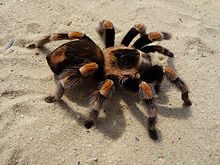
Around here, in Bandelier National Monument and many other parts of New Mexico, everyone starts noticing tarantulas about this time of year. Autumn is the time when males mature and start out on their quest to find a mate. This exposes them to many dangers, from hawks and skunks, which want to eat them, to fast-moving cars, to people who just find them creepy and may think they should be squashed.
Tarantulas have been around for more than 16 million years, and comprise more than 900 species found across the world. They do have venom, but in ones around here, it is about equivalent to a wasp sting unless someone is allergic to the proteins that accompany the venom. New world tarantulas also have barbed urticating (stinging) bristles which they can brush from their abdomens in self defense; these are particularly harmful if breathed into the lungs, and can do permanent damage to eyes. But generally tarantulas are pretty easy-going creatures.
They are spiders, with eight legs, even though they have two other sets of appendages that sometimes make it look like they have 12 legs. Tarantulas are hunters, preying on such creatures as centipedes, millipedes, beetles, and even smaller spiders. In turn, they are considered food by predators including hawks, owls, coyotes, foxes, and snakes. They are very long lived, given the chance; females may live 30-40 years, spending most of that time in their burrow when they’re not hunting. Males mature in 2-5 years and seldom live more than a year or so after that, partly because of having to go out into the world to find a female.
The wandering individuals seen in fall on the roads and elsewhere are almost certainly males, trying to reproduce in the short time available to them. The females stay at their burrows, and the males follow hormone scents to try to find them. If you see one of these males, be kind. Remember that all native creatures are protected in Bandelier National Monument. If he’s in a dangerous location like a road, and it’s feasible, consider helping him across. Definitely be aware for your own safety – fast-moving cars aren’t good for people, either. Wear gloves, or find something flat for him to crawl onto. Place him off the road or trail in the direction he was traveling. Certainly don’t squash him. Let him proceed on his mission to provide future generations of tarantulas! Hopefully these big hairy spiders will share the earth with us for another 16 million years.
For information about Bandelier National Monument, contact the Bandelier Visitor Center at 505-672-3861 x 517 or visit www.nps.gov/band, on Facebook, BandelierNPS.
About the National Park Service. More than 20,000 National Park Service employees who care for America’s 417 national parks and work with communities across the nation to help preserve local history and create close-to-home recreational opportunities. Visit us at https://www.nps.gov, on Facebook www.facebook.com/nationalparkservice, Twitter www.twitter.com/natlparkservice, and YouTube www.youtube.com/nationalparkservice.
For further information contact: Joanie Budzileni, 505-672-3861, ext. 511 — Bandelier National Monument, 15 Entrance Road, Los Alamos, NM 87544
++++++++++
Study tests whether seaweed in cattle feed reduces emissions
By Terence Chea –
DAVIS, Calif. (AP) — University of California researchers are feeding seaweed to dairy cows in an attempt to make cattle more climate-friendly.
UC Davis is studying whether adding small amounts of seaweed to cattle feed can help reduce their emissions of methane, a potent greenhouse gas that’s released when cattle burp, pass gas or make manure.
In a study this past spring, researchers found methane emissions were reduced by more than 30 percent in a dozen Holstein cows that ate the ocean algae, which was mixed into their feed and sweetened with molasses to disguise the salty taste.
“I was extremely surprised when I saw the results,” said Ermias Kebreab, the UC Davis animal scientist who led the study. “I wasn’t expecting it to be that dramatic with a small amount of seaweed.”
Kebreab says his team plans to conduct a six-month study of a seaweed-infused diet in beef cattle starting in October.
More studies will be needed to determine its safety and efficacy, and seaweed growers would have to ramp up production to make it an economical option for farmers.
Dairy farms and other livestock operations are major sources of methane, a heat-trapping gas many times more potent than carbon dioxide.
(For the balance of this article, plus a video, visit: https://www.apnews.com/835789442443441baab77a3077870634)
++++++++++
Modular hexa-hives claimed to be better for your bees
A new beehive system made up of a series of hexagonal prisms may be just what your bees need. The Honeycomb Hives system is designed to tackle bee colony losses by making hives which apparently keep pests out, get rid of condensation and which retain heat more efficiently – all problems which can be a bane to honey bees.
As you may have guessed, the hexagonal shape is the key. Take condensation, for example. The creators of Honeycomb Hives reckon flat-top hives will cause condensation to drip back down onto the bees, which can be lethal to them in winter (I’m no bee expert, but a spot of Googling seems to confirm that this is indeed a thing.) A hexagonal prism affords an angled roof, so the condensation runs down these and the side walls, causing less damage.
Temperature-wise, the advantages of the hexagonal shape are down to the ratio of comb space to box space, which means the bees have to work less hard to stay warm (so the theory goes). The makers of Honeycomb Hives also claim their build quality means fewer “crevices, corners and cracks” for predators like moths and beetles to hide in.
The hives come in a couple of configurations for bee-ginners. The Starter Hive is ideal for absolute novices, needless to say. Flex-Hives are a step up, offering newbies a bit more flexibility to organise a small colony in different ways. The aptly-named Long-Hives are designed for larger colonies and apparently offer even greater flexibility in setting up a hive as you’d like.
The modular, stackable Fold-Hives are where the real action is (says the chap that knows nothing about beekeeping). It appears that these can be stacked and scaled as needed, reducing the amount of lifting required, and only a few bees are exposed at any one time when removing covers.
Honeycomb Hives can come with numerous accessories, including various frames, feeders, observation panes and pollen traps, as well as Nuc Boxes for attracting and catching swarms of bees.
The creators of Honeycomb Hives are seeking funding on Kickstarter, where you’ll be stung for US$147 for a super early bird Starter-Hive. Flex-Hives start at $287 while a three Fold-Hive system starts at $447. The bees’ knees, a 7-unit Fold-Hive, can be had for $997.
Should all go well, Honeycomb Hives are due to ship in March 2019, should the campaign reach its target, which is looking by no means certain at this stage. Still, given the recent news that honey is quite a good thing to take if you have a cough (probably), perhaps it’s not a bad time to get into beekeeping.
Check out the buzz in the video at: https://newatlas.com/honeycomb-hives/56126/
(Source: Kickstarter by way of https://newatlas.com/honeycomb-hives/56126/)
++++++++++
Prehistoric turtle lacked a shell, but had a beak
 Eorhynchochelys, depicted in its natural habitat (Credit: IVPP).
Eorhynchochelys, depicted in its natural habitat (Credit: IVPP).
In the past decade, scientists have discovered the fossilized remains of two prehistoric turtles that had a partial shell, but that lacked the toothless beak of modern turtles. Recently, however, a fossil turtle was found that had no shell at all, but that did have a beak. It’s given scientists a new understanding of the animals’ evolution.
Known as Eorhynchochelys sinensis, the turtle was over six feet long (2 m) and lived approximately 228 million years ago – it likely inhabited shallow waters where it foraged in the mud for food. Its fossilized skeleton was unearthed in China, by a team led by Li Chun of China’s Institute of Vertebrate Paleontology and Paleoanthropology.
(Credit: Adrienne Stroup, Field Museum)
Although its long-tailed body did have the “Frisbee shape” of today’s turtles, its spine and ribs still hadn’t joined together to form a single shell. The front part of its jaws, however, had already developed into a beak.
According to a new international study, the fact that it had a beak before other ancient turtles, but it didn’t have the partial shell that they did, is an example of mosaic evolution. Essentially, this means that different ancestral species of a modern animal evolved different traits at different times, with those traits eventually all occurring in one animal.
“This impressively large fossil is a very exciting discovery giving us another piece in the puzzle of turtle evolution,” says Nick Fraser, an author of the study from National Museums Scotland. “It shows that early turtle evolution was not a straightforward, step-by-step accumulation of unique traits but was a much more complex series of events that we are only just beginning to unravel.”Additionally, features of the turtle’s skull indicate that it was part of the diapsid family of reptiles, which also includes modern lizards and snakes. Previously, scientists had wondered if prehistoric turtles instead belonged to the anapsid family.
“With Eorhynchochelys’ diapsid skull, we know that turtles are not related to the early anapsid reptiles, but are instead related to evolutionarily more advanced diapsid reptiles,” states another of the study’s authors, Olivier Rieppel of Chicago’s Field Museum. “This is cemented, the debate is over.”
Eorhynchochelys, incidentally, is Latin for “dawn beak turtle” (as in the first beaked turtle), while sinensis means “from China.”
The study, which also involved scientists from the CAS Center for Excellence in Life and Paleoenvironment, and the Canadian Museum of Nature, is described in a paper that was recently published in the journal Nature.
(Sources: Field Museum, Naturevia: https://newatlas.com/prehistoric-beaked-shell-less-turtle/56037/)
++++++++++
The Super Bowl of Beekeeping
Almond growing in California is a $7.6 billion industry that wouldn’t be possible without the 30 billion bees (and hundreds of human beekeepers) who keep the trees pollinated — and whose very existence is in peril.
By Jaime Lowe –

++++++++++
In Feral, his book proposing a re-wilding of our natural environment, George Monbiot refers to Shifting Baseline Syndrome as a major cause in our misperception of what is ‘natural’.
As individuals, we lack a multi-generational perspective. Our environment is in its ‘natural’ state when we are young, or so we assume. The only environmental destruction we really notice is what occurs within our own lifetimes.
Humanity’s baseline for what is natural keeps shifting with every new generation, clouding our view on longer processes of environmental damage and degradation.
Shifting Baseline Syndrome can have perverse effects on our attempts at nature conservation – sometimes, we conserve the environmental destruction, rather than restoring the environment to its previous natural state.
Monbiot has a particular bone to pick with the sheep that are used to maintain large tracts of Britain in a near-desert condition. Those sheep are an invasive species, he argues, and the medieval switch to a wool-based economy destroyed the richly biodiverse forests that covered most of the island.
America too is subject to the paradox of ecological degradation: its scope is so massive that it’s hard for us as individuals to notice. These maps suggest some interesting markers to get a sense of the discrepancy between our ‘natural environment’, and that of previous generations.
They compare the geographic spread of cities and towns (see note #1, below) in America named after native animals and the current geographic distribution of those species. As you may have expected, most indicate a huge reduction in the range of said animals.
Let’s start with bears: as the map indicates, they roam far and wide: from the Appalachians all the way into Maine, on the coasts of Virginia, in Florida, along the Mississippi in Louisiana, in Arkansas and Missouri, throughout the west and the Pacific states. Most ‘bear’ towns align more or less with the animal’s current range:
- Bear Valley and Bear Valley Spring, Big Bear City (2) and Big Bear Lake (all in California),
- Bear River in Wyoming and Bear River City in Utah;
- White Bear Lake in Minnesota, Upper Bear Creek in Colorado and Bear Creek Village in Pennsylvania;
- Bear Rocks also in Pennsylvania and Bear Dance in Montana;
- Bear Flat in Arizona and Bear Grass in North Carolina;
- Three places called Bear Lake (two in Michigan (3) and one in Pennsylvania);
- and four towns all called Bear Creek (in Montana, Wisconsin, Florida and California).
But some indicate that the majestic predator once had an even wider distribution:
- two towns also called Bear Creek, in Texas and Alabama;
- Four Bears Village in North Dakota;
- and a town simply called Bear, in Delaware.

It’s worse for wolves: they’re limited to two relatively small areas near the Canadian border, far away from most ‘wolf’ towns:
- Two towns called Wolf Lake, one in Minnesota, the other in Michigan;
- Wolf Point, Montana (4) and Wolf Creek, Utah;
- Lone Wolf, Oklahoma (5) and Wolfdale, Pennsylvania;
- Wolf Summit, West Virginia and Wolf Trap, Virginia.

Judging by the places named after the animal, elk used to be prevalent across most of the country. ‘Elk’ towns are concentrated in the Midwest:
- Elk Run Heights and Elk Horn, both in Iowa (6);
- Elk Point in South Dakota and Elk Creek in Nebraska;
- Elk River in Minnesota and Elk Mound in Wisconsin;
- Elk City and Elk Falls, close to each other in Kansas; and another Elk City in Oklahoma.
Some elk towns are further east:
- Elk Rapids in Michigan, Elk Grove Village (7) in Illinois and Elk Creek in Kentucky;
- Banner Elk (8), North Carolina and Elk Garden, West Virginia.
The current range is limited mainly to the Rockies and the Pacific Northwest, with small scattered patches elsewhere. Some elk towns actually in elk country:
- Elk Creek and Elk Grove, both in California;
- Elk City and Elk River, both in Idaho;
- Elk Plain in Washington and Elk Ridge in Utah and Elk Mountain (9) in Wyoming.

Badgers are holding firm in most of the country, absent only from the eastern third of the country (and a small part of the northwest). There are still badgers in all badger towns on this map:
- Three towns simply called ‘Badger’ (in Minnesota, South Dakota and Iowa);
- and one called Badger Lee, Oklahoma.
Beavers are everywhere, except in much of California, Nevada and Florida. And so are beaver towns, with concentrations in Pennsylvania, Ohio, Nevada and Oregon.
- Seven towns are just called ‘Beaver’ (in Arkansas, Iowa, Ohio, Oklahoma, Oregon, Utah and West Virginia);
- Six towns called ‘Beaver Creek’ (two in Ohio, one each in Oregon, Maryland, Minnesota and Montana);
- Five towns called ‘Beaver Dam’ (in Arizona, Kentucky, Ohio, Nevada and Wisconsin);
- Three towns called ‘Beaverton’ (in Alabama, Michigan and Oregon) and two called ‘Beaverdale (in Iowa and Pennsylvania);
- And then there’s Beaver Valley in Arizona, Beaverville in Illinois, Beaver City and Beaver Crossing in Nebraska, Beaver Bay in Minnesota and Beaver Dam Lake in New York, and Beaver Falls and Beaver Springs in Pennsylvania (10).

- Poor wolverines: clinging on to a dwindling strip of land in the northwest, with small colonies remaining in California and on the Nevada-Utah border. Where are the times when they roamed Michigan in such numbers that two towns in that state – Wolverine Lake, near Detroit, and Wolverine, near the top of the state’s Lower Peninsula – were named after them?Map found here at Data is Beautiful on Reddit.Strange Maps #931Got a strange map? Let me know at strangemaps@gmail.com.
 (1) The dots represent populated places, i.e. cities, towns or census-designated places as defined by the U.S. Census Bureau. The maps do not include other topographical features named after said animals (e.g. Wolverine, an unincorporated community in Kentucky, Wolverine Canyon in Utah, Wolverine Creek in Kansas, or Wolverine Hill and the Wolverine Mine, both in Michigan). Species ranges come from natureserve.org.(2) Big Bear City is the location of a quartz dome that is worshipped as the Eye of God by the Serrano, a tribe native to the area.(3) One township in Kalkaska County, the other in Manistee County.(4) A city in the Fort Peck Indian Reservation and the home of the annual Wild Horse Stampede, “the Grandaddy of Montana Rodeos”.(5) Named after a Kiowa chief rather than the animal.(6) But not Elkader, named after Abdelkader ibn Muhieddine, a 19th-century Algerian fighter against French colonialism.(7) Despite being surrounded by a largely industrial area and its proximity to O’Hare International Airport, Elk Grove Village is home to a small herd of elk – indeed kept in a grove. The herd was brought to the area in the 1920s and is maintained by the Chicago Zoological Society. Unrelatedly, Elk Grove Village also is the hometown of Billy Corgan and James Iha, both of the band Smashing Pumpkins.(8) By the early 19th century, elk had disappeared from the area. The National Park Service has now reintroduced small numbers of elk to western North Carolina.(9) The setting of Elk Mountain, a graphic novel about the relationship between superheroes and the communities they defend.(10) That’s not counting the names of half a dozen other places in Pennsylvania, including Big Beaver and New Beaver.
(1) The dots represent populated places, i.e. cities, towns or census-designated places as defined by the U.S. Census Bureau. The maps do not include other topographical features named after said animals (e.g. Wolverine, an unincorporated community in Kentucky, Wolverine Canyon in Utah, Wolverine Creek in Kansas, or Wolverine Hill and the Wolverine Mine, both in Michigan). Species ranges come from natureserve.org.(2) Big Bear City is the location of a quartz dome that is worshipped as the Eye of God by the Serrano, a tribe native to the area.(3) One township in Kalkaska County, the other in Manistee County.(4) A city in the Fort Peck Indian Reservation and the home of the annual Wild Horse Stampede, “the Grandaddy of Montana Rodeos”.(5) Named after a Kiowa chief rather than the animal.(6) But not Elkader, named after Abdelkader ibn Muhieddine, a 19th-century Algerian fighter against French colonialism.(7) Despite being surrounded by a largely industrial area and its proximity to O’Hare International Airport, Elk Grove Village is home to a small herd of elk – indeed kept in a grove. The herd was brought to the area in the 1920s and is maintained by the Chicago Zoological Society. Unrelatedly, Elk Grove Village also is the hometown of Billy Corgan and James Iha, both of the band Smashing Pumpkins.(8) By the early 19th century, elk had disappeared from the area. The National Park Service has now reintroduced small numbers of elk to western North Carolina.(9) The setting of Elk Mountain, a graphic novel about the relationship between superheroes and the communities they defend.(10) That’s not counting the names of half a dozen other places in Pennsylvania, including Big Beaver and New Beaver. - (Source of article, and for other fascinating articles, visit: https://bigthink.com/strange-maps/these-maps-show-how-much-range-americas-wild-animals-have-lost/)
++++++++++
Accident-Prone Koala Rescued For Third Time After Getting Stuck In Fence
The large male adult koala was totally calm when a rescue organization found and unhooked him.
We’ve all had bad days here and there, but this poor koala seems to have had more than a few.
A South Australia koala had to be saved by Fauna Rescue of South Australia volunteers for the third time when he was found stuck in a fence at the SA Power Networks’ Happy Valley substation.
Fauna Rescue volunteer Sally Selwood told Adelaide Now that it looked “like he’s crawled under the fence to go somewhere, as they do, and then sat up as he was under the fence and got his head caught.”
“But he didn’t have the brains to bob back down again to get out.”
OK, Sally. Or maybe he just wanted to see his volunteer friends again — specially when you consider that Selwood also told the publication that the koala was “quite calm” and that he’s “known” to them.
Previously, the koala ran into trouble when he was found at the bottom of a tree in January 2016. He was “not very responsive” and subsequently spent a week with Fauna Rescue until he was well enough to be released back into the wild.
In an unlucky twist of fate, Fauna Rescue had to care for him again in November 2016 after he was hit by a car. He spent some more time in their care and was purportedly totally OK until his most recent fence incident.
While most koalas don’t resemble cats with their seemingly nine lives, this eucalyptus-loving friend does. Here’s hoping he has many more accident-free adventures in the future!
(Source of article and additional comments: https://www.huffingtonpost.com/entry/accident-prone-koala-rescued-for-third-time-after-getting-stuck-in-fence_us_5b5211a2e4b0b15aba8e7878/)
++++++++++
More than 100 goats descend on a neighborhood in Boise
The goats chowed down on flowerbeds, leaves and grass before being rounded up.
by Ethan Sacks –
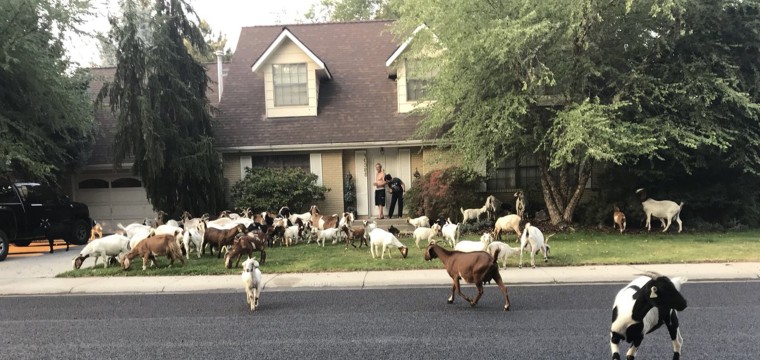
Residents of an Idaho neighborhood woke up Friday morning to a sight that really got their goat.
An invading herd of more than 100 goats rampaged through the neighborhood of West Boise, devouring flowerbeds, grass and leaves as they moved from yard to yard on a recent Friday morning, NBC affiliate KTVB reported.
Representatives of the company that owns the animals, We Rent Goats, arrived at the scene and managed to herd the goats onto a truck around 9 a.m., less than two hours after the initial calls were fielded by Animal Control.
As the goats were rounded up by their handlers, a throng of onlookers and reporters — rivaling the goat herd in size — gathered to watch.
“The neighborhood banded together to force them into one lawn while they were waiting for us,” We Rent Goats owner Matt Gabica told NBC News. “Everyone seemed to be enjoying it. There were tons of little kids around there. Mothers brought infants in strollers to see the goats.”
We Rent Goats, according to its website, provides rentals of herds of the animals to landowners in need of mowing large swathes of grass. The animals apparently specialize in chowing down on weeds.
The animals apparently specialize in chowing down on weeds.

“The company has insurance and will be following up with neighbors whose landscaping was damaged. Animal control will also be following up with the company,” Boise city government spokesman Mike Journee said in an email.
The 118 goats that got loose were originally corralled near Ada County Highway District retention pond, broke through several slats of a wooden fence to scour the area for more food, the Idaho Statesman reported.
The breakout wasn’t exactly the stuff of heist movies.
“Apparently, they just leaned on the fence and it broke,” said Gabica.
(To see a video of the “goat invasion” visit: https://www.nbcnews.com/news/us-news/more-100-goats-descended-neighborhood-boise-n897356/)
++++++++++
Scientists discover rare dolphin-whale hybrid near Hawaii
A wholphin? A dhale? It’s actually called a…
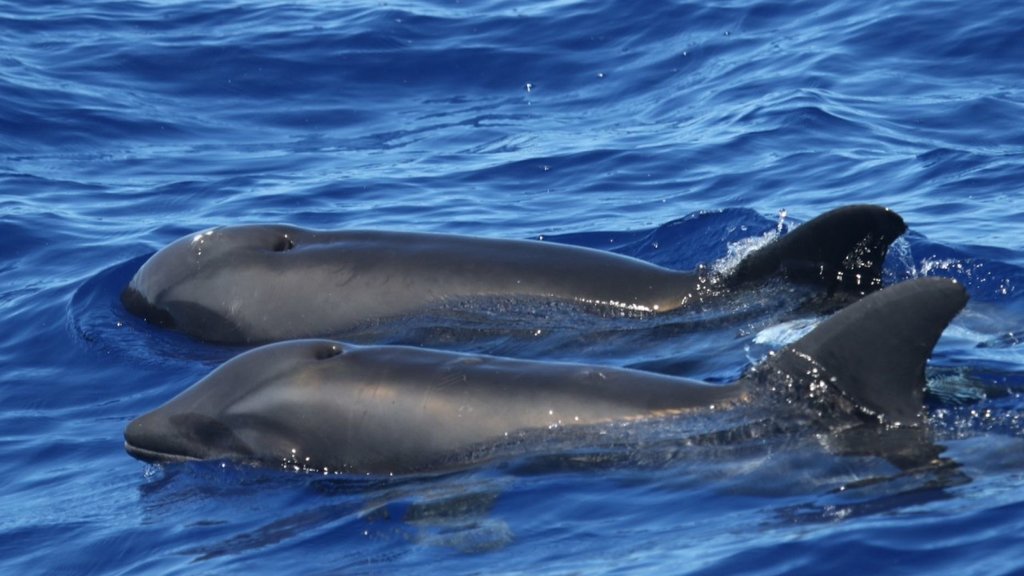
Kimberly A. Wood under Cascadia Research Collective NMFS permit 20605
Scientists have discovered a rare hybrid between a melon-headed whale and a rough-toothed dolphin in waters near Kauai, Hawaii.
The discovery, made last year, was confirmed this week in a report released by researchers with the Cascadia Research Collective, a nonprofit which in August 2017 conducted a two-week project to photograph, tag and record audio of marine mammals.
The hybrid was the team’s “most unusual finding,” said project lead Robin Baird.
“We had the photos and suspected it was a hybrid from morphological characteristics intermediate between species,” Baird told The Garden Island newspaper. “We were able to get a biopsy sample of the animal.”
A genetic analysis revealed the animal was likely a first-generation hybrid between a female melon-headed whale (a rarely seen type of whale) and a male rough-toothed dolphin, marking what’s thought to be the first-ever documented discovery of a hybrid between the two mammals.
The researchers named it steno bredanensis.
“Hybrids among different species of whales and dolphins have been previously recorded, but this is the first case of a hybrid between these two species, and only the third confirmed case (with genetics) of a wild-born hybrid between two species in the family Delphinidae,” or oceanic dolphins, Baird told Fox News.
The dolphin hybrid was a rare find, but crosses between species in the animal kingdom are actually quite common.
A mule, for instance, is a hybrid between a male donkey and a female horse. There’s also more exotic hybrids–zonkeys (donkey and zebra), ligers (lion and tiger), pizzlies (polar and grizzly bear), beefalo (domestic cow and buffalo) and wolfdogs. And, perhaps surprisingly, you might even be a hybrid yourself, considering scientists have identified slight traces of Neanderthal DNA in humans.
Many animal hybrids are possible, but few survive past the first generation. That’s because two animal species are unlikely to have the same number of chromosomes, and hybrids won’t be able to reproduce if their parents are too genetically dissimilar. Even if hybrids can reproduce, they’d likely face other challenges in their environment, like being disadvantaged by their uniquely inherited traits or competition from other species. It’s for these reasons that hybrids in the plant kingdom are often more successful.
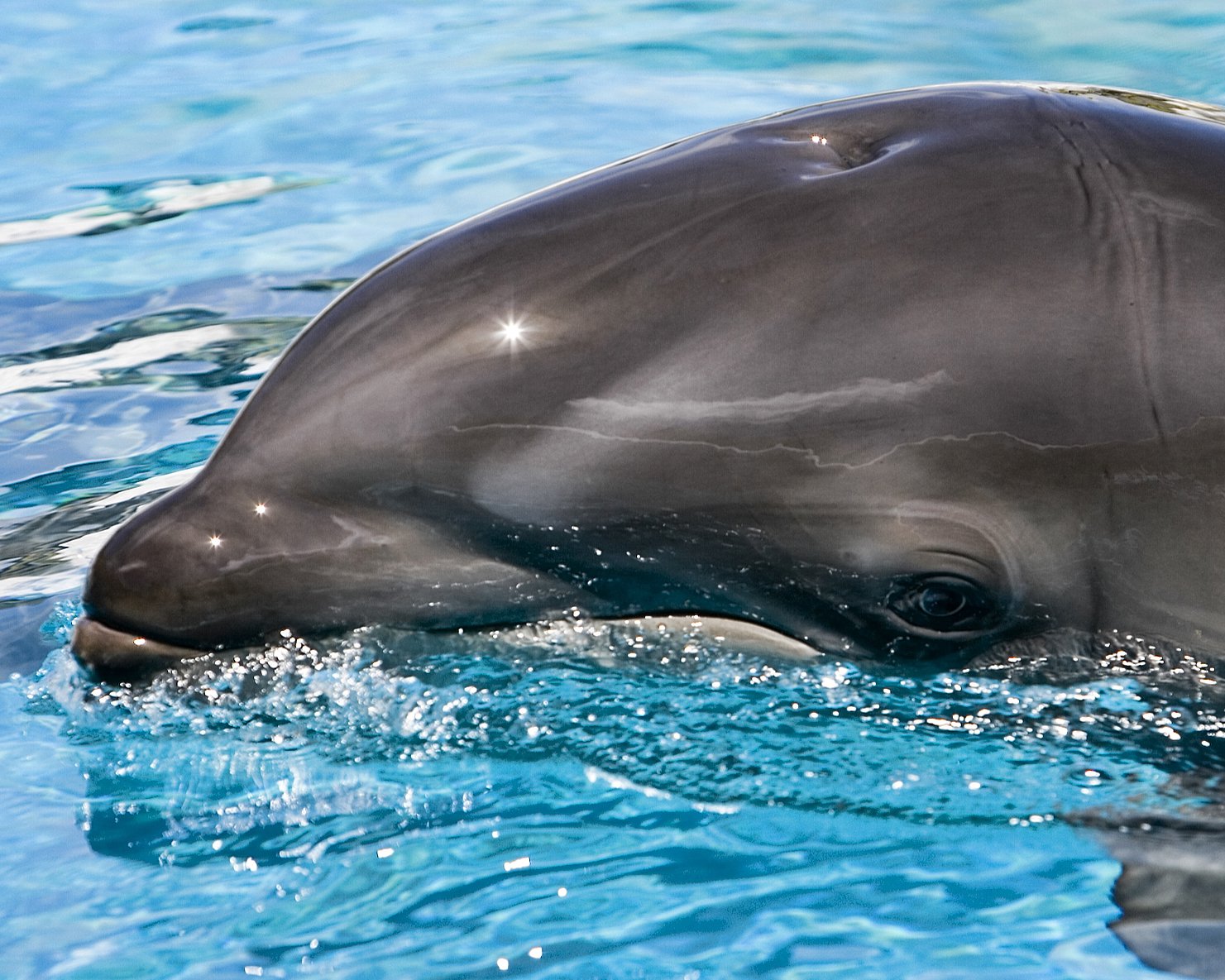 Mark Interrante – wholphin – via Flickr
Mark Interrante – wholphin – via Flickr
Still, some dolphin hybrids have successfully reproduced. Kekaimalu, the only known living first-generation wolphin, which is a cross between a false killer whale and Atlantic bottlenose dolphin, gave birth to a female calf in 2004, and today the two live together at Oahu’s Sea Life Park. However, that baby was the result of her third pregnancy; her first offspring died in infancy, the other at age 9.
Much remains a mystery about the newly discovered dolphin hybrid, but the Cascadia Research Collective team hopes to learn more about it and other marine mammals in another project in the Hawaiian waters this August.
(Article source: https://bigthink.com/stephen-johnson/scientists-discover-rare-dolphin-hybrid-near-hawaii)
++++++++++
1 Hen, 76 Ducklings: What’s the Deal With This Picture?
Where she goes, they follow. All 76 of them.
A female duck in Minnesota has about six dozen ducklings in her care, a remarkable image that an amateur wildlife photographer captured on a recent trip to Lake Bemidji, about 150 miles northwest of Duluth, Minn.
“It was mind blowing,” the photographer, Brent Cizek, said in an interview. “I didn’t know that a duck could care for that many chicks.”
It’s not unusual to see many ducklings gathered together. Some 20 or 30 have been reported with a single hen. But 70-plus?
“It’s an extraordinary sighting,” said Richard O. Prum, an ornithologist at Yale University.
Experts say the photo, which has been shared among bird conservationists and featured on the National Audubon Society’s website, offers an extreme example of a somewhat common phenomenon in nature. Here’s a look at the story — and the science — behind the striking image.
(For the complete article please see: https://www.nytimes.com/2018/07/24/science/merganser-ducklings-photo.html)
++++++++++
There’s a Really Weird Link Between Cats And Entrepreneurs
Is this for real?
Paul Hanaoka – https://unsplash.com/photos/OvLBv6F6DGE.
A protozoan parasite found in cats could be having a rather odd effect on the brains of humans it infects, which under the right circumstances just might turn them into the next Elon Musk.
Toxoplasma gondii is famous for messing with the minds of mice, robbing them of the ability to evaluate risk. There’s some circumstantial evidence hinting at a similar effect on our own minds, which although tenuous, is well worth a closer look.
Research led by the University of Colorado has combed databases of information examining the coincidence of T. gondii infections and entrepreneurial activity across the globe.
They also turned to students and business professionals for a simple spit-test to track their body’s history of Toxoplasma gondii.
The research team was looking for some hint that there was a relationship between the go-getting, risk-taking characteristics of business hot-shots and a past brush with the mind-bending parasite. Which was pretty much what they found.
Almost 1,500 students who tested positive for exposure to T. gondii were 1.4 times more likely to be a business major. They were also 1.7 times more likely to have an emphasis on ‘management and entrepreneurship’.
As for the 197 business professionals the researchers evaluated, being T. gondii positive made them 1.8 times more likely to have started their own business at some point.
Country-level databases on infection rates over the past 25 years also showed an interesting pattern – there was a consistent pattern where infections could be used to predict business startups, as well as a lower reported fear of failure.
At face value, we could assume Toxoplasmosis might do weird things to the brain, potentially lowering inhibitions that might make the rest of us a little more concerned about the risks of sinking time and money into a new venture.
After all, the microscopic cat-borne pathogen responsible for the disease can turn the average cowering mouse into a rodent that shows no aversion to the smell of cat, while causing them to forget where they are.
It’s thought this could be an evolved characteristic, helping the parasite jump between cats through their food supply.
This raises the question of whether there’s a similar neurological effect on humans. It certainly seems to play havoc with our immune system, rewiring our inflammatory response in order to survive.
But our own brains?
On one hand, we’re hardly cat food. On the other, mice are often used as miniature models of human biology – the development of similar symptoms in us isn’t inconceivable.
Some studies hint that a T. gondii infection could make some people more aggressive. But the numbers aren’t convincing, and counter studies have failed to make links between psychological conditions or personality traits and the disease.
This new approach suggests something more subtle could be going on – an influence that isn’t significant enough to give rise to serious psychological conditions, but one that could still potentially nudge people into throwing caution to the wind.
It’s not the first study to step back and look for subtle signs of the parasite’s gentle persuasion across a culture.
Other studies have noticed a correlation between infection rates and neuroticism, for example.
Others have found a negative link between T. gondii and economic performance, suggesting what makes some people risk-takers could increase insecurity and low ability to trust, weakening institutions rather than helping them grow.
The usual caveats concerning correlations apply here, and it’s important not to take the sum of research together in drawing conclusions.
Nobody is suggesting you should go out and buy your kids a cat in the hope it will infect them with the skills to help them to take over Silicon Valley.
Nonetheless, the study does provide an interesting perspective on the ways epidemiology can have a small but powerful force on the psychology that builds culture.
And maybe, just maybe, shows why cats deserve their place of worship on the internet.
The findings are due to be published in Proceedings of the Royal Society B.
(For the source of this and other interesting articles please see: https://www.sciencealert.com/toxoplasma-gondii-correlation-entrepreneurial-characteristics-global-economics/)
++++++++++
Game Cam Captures Bear Bathing On Barranca Mesa (Los Alamos)
A game cam captures a bear taking a bath earlier this month in the backyard of a home on Kachina Street on Barranca Mesa in Los Alamos, NM. Photo by Andrew Delorey
(For more interesting Los Alamos related stories visit: https://www.ladailypost.com/content/game-cam-captures-bear-bathing-barranca-mesa/)
++++++++++
The Insane-Sounding But Totally Real World War II Plot to Bomb Japan With Bats
++++++++++
Dogs excel at sniffing out human illness
Now researchers are trying to build a machine version of the perfect dog nose
Photo by Stéphane Juban on Unsplash
 Christa Trexler – Cardiology UC San Diego –
Christa Trexler – Cardiology UC San Diego –
++++++++++
200-million year old monster pushes back the clock on giant dinosaurs
 At about 10 tons, Ingentia prima was the first giant dinosaur (Credit: Jorge A. González)
At about 10 tons, Ingentia prima was the first giant dinosaur (Credit: Jorge A. González)
Most of the classic creatures that come to mind when you think of dinosaurs are from the Cretaceous period, when evolution seems to have hit its stride and splashed out with things like the huge, long-necked sauropods. But dinosaurs weren’t always giants – during the earlier Triassic period they were mostly chicken-sized critters, and they didn’t really grow to be massive until the Jurassic. Now, the discovery of a new species in Argentina is pushing back the clock on dinosaur gigantism by up to 30 million years.
The creature has been dubbed “Ingentia prima” (Latin for “first giant”), and it’s been classed as a sauropodomorph, the group that would later evolve into the gigantic sauropods. Although it has a much shorter neck and more theropod-like feet, the family resemblance is clear. Ingentia has been estimated to have weighed about 10 tons, which is huge for its time but makes it a relative lightweight next to some of its descendants like Patagotitan, the largest land animal to ever walk the Earth.
“Before this discovery, gigantism was considered to have arisen during the Jurassic period, about 180 million years ago, but Ingentia prima lived at the end of the Triassic, between 210 and 205 million years ago,” says Cecilia Apaldetti, lead author of a study describing the new find. “It is a true giant, especially for that moment of evolution where most of the animals that coexisted did not exceed two meters in height and the largest reached, at most, three tons.
“That is why we see in Ingentia prima the origin of gigantism, the first steps so that, more than 100 million years later, sauropods of up to 70 tons will come into being, as Argentinosaurus or Patagotitan, from southern Argentina.”

The team also found biological evidence for just how the creature managed to get so big so early. Ingentia seems to have had a respiratory system much like that of modern birds: in addition to lungs, it had a pair of air sacs that would allow it to have a reserve of oxygenated air and let it cool down faster.
“Ingentia had pneumatic cavities in its bones, which indicates the presence of highly developed air sacs, a very efficient breathing system such as that of current birds, and that consequently lightened his weight,” says Oscar Alcober, co-author of the study.
(For the balance of this article please visit: https://newatlas.com/isgentia-prima-first-giant-dinosaur/55408/)
++++++++++
Seal jumps onto fishing boat to escape hungry killer whales
By Ben Hooper –

A quick-thinking seal managed to avoid becoming a meal for some killer whales by boarding a nearby charter fishing boat.
Nick Templeman said he and a partner were doing a survey on transient orcas when they spotted a pod of the killer whales chasing a seal near Campbell River in the waters of British Columbia.
Templeman said the seal took off swimming toward a nearby charter boat.
“When it all took place, it took literally about 30 seconds for that seal to come over 150 feet towards the other boat,” Templeman told CTV News. “All of a sudden it comes up and around, up on the swim grid, and it all just started to take place, just like that.”
The seal jumped up onto the Pacific Yellowfin, a charter boat captained by Colin Griffinson of Pacific Yellowfin Charters.
“We said, what will we call the seal if we actually ended up keeping it?” Griffinson told the Columbia Valley Pioneer. “We just joked that we’d call it Lucky.”
Video filmed aboard the boat shows the seal hiding at the back near the motors while the killer whales swam nearby.
(For full story, and video, visit: https://www.upi.com/Odd_News/2018/07/05/Seal-jumps-onto-fishing-boat-to-escape-hungry-killer-whales/5591530797214/)
++++++++++
++++++++++
India Court Declares Legal Rights of “Entire Animal Kingdom”
“Animals cannot be treated merely as Property”
By Mari Margil –

On July 4, the High Court of Uttarakhand at Naintal in northern India issued a ruling in a case brought to end cruelty of horses used in transport. The court declared that:
“Every species has an inherent right to live and are required to be protected by law.”
The decision is part of unprecedented advancement in the growing Rights of Nature movement that includes the work of the Community Environmental Legal Defense Fund (CELDF). Beginning in 2006, CELDF assisted the first communities in the United States – the very first places in the world – to advance the rights of nature into law. CELDF has now assisted more than three dozen communities across the U.S., as well as the first country in the world – Ecuador – to secure the rights of nature to exist and flourish.
In this week’s India case, Narayan Dutt Bhatt v. Union of India & others, the High Court explained that declaring the animal kingdom as possessing rights is necessary “in order to protect and promote greater welfare of animals including avian and aquatic.”
Citing the growing extinction rates of animals – which today exceeds 1,000 times natural background rates – the Court explained, “The loss of one species causes immense damage to the entire ecosystem.”
Further, the Court explained that the growing environmental crises across the globe – including climate change – reveals “there are gaps in laws” that need to be addressed to protect the environment.
Such laws treat nature, including animals, as property without legal rights. The Court asserted that this needs to change. “Animals cannot be treated merely as property” existing for human use. Rather, the Court wrote that to address this deficiency in the law related to the environment, “New inventions are required to be made in law to protect the environment and ecology,” including the recognition of legal rights of nature.
The ruling by the High Court follows rulings it issued in 2017. The Court declared legal rights of certain ecosystems, including the Ganges River. Similarly in Colombia, the Courts issued two rulings in which the Atrato River and the Colombian Amazon region now possess legal rights.
Courts are reaching these decisions as they witness the severe decline of the environment, despite numerous environmental laws. As Colombia’s Constitutional Court explained in its 2016 decision recognizing rights of the Atrato River, in which it described the many ways in which human activity was jeopardizing the environment, “(J)ustice with nature must be applied beyond the human scenario and must allow nature to be a subject of rights. Under this understanding, the Court considers it necessary to take a step forward in jurisprudence….”
In its ruling this week, the High Court describes the growing movement to recognize rights of nature.
(For the balance of this article please visit: https://celdf.org/2018/07/press-release-india-court-declares-legal-rights-of-entire-animal-kingdom/)
++++++++++
Crickets are Nature’s Thermometer: How Counting Cricket Chirps Can Tell the Temperature
By Gerard West –
There are many reasons why crickets chirp to one another. It is a way for them to communicate. Crickets will chirp to warn each other of approaching danger. Male crickets chirp to scare off other males from getting the female they have their sights set on, and then use chirping to attract the female. Crickets chirp by rubbing the edges of their wings together.
But did you know they can also communicate with us in a very specific way? Crickets’ chirps can tell us the temperature!
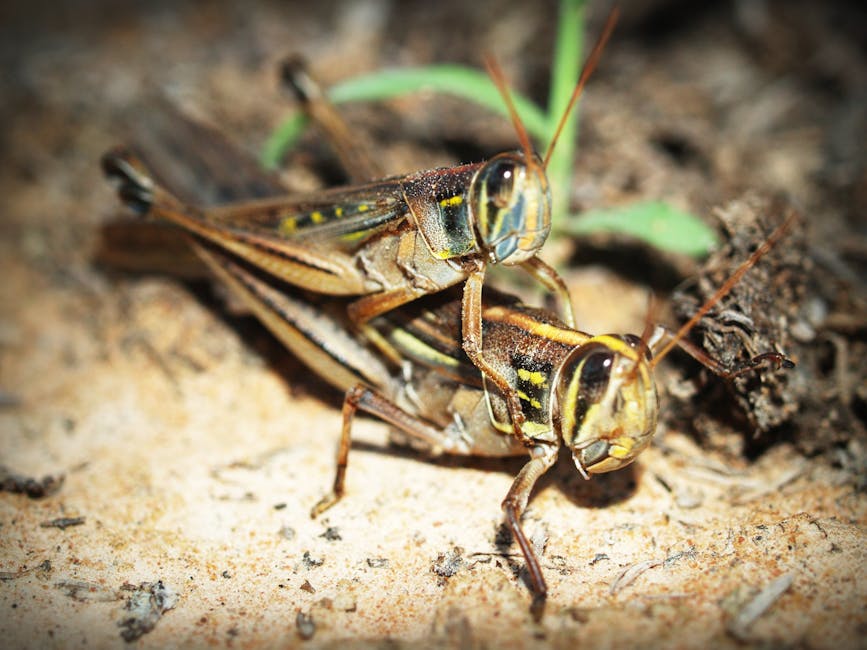 Pexels.com
Pexels.com
Counting Crickets’ Chirps
Two methods exist to tell the current temperature by counting cricket chirps. One converts cricket chirps to Fahrenheit, and the other converts them to Celsius.
To convert cricket chirps to Fahrenheit, count the number of chirps that occur within 14 seconds. Then, add 40 to the number to get the temperature.
An example is: 25 chirps + 40 = 65 degrees Fahrenheit
In order to convert cricket chirps to Celsius, count the number of chirps within 25 seconds. Then divide that number by 3, and then add 4 to get the temperature in Celsius.
An example is: 30 chirps/3 + 4 = 14 degrees Celsius
Why Does Counting Crickets’ Chirps Work?
Crickets are cold-blooded like all insects. They adapt to the temperatures around them. So, the temperature outside affects the amount of energy crickets have available to chirp, among other chemical bodily actions.
When the temperature is warm, crickets are able to chirp at a faster rate. When the temperature is cool, their chirping slows down. This is one reason you may not hear crickets chirping in the winter months, whereas a hot summer night is full of them. For many, cricket chirping is a sound synonymous with summertime.
++++++++++
Why This Dutch Town Installed Bat-Friendly LED Street Lights
By Brian Spaen –
Street lights give us an easier path for transportation at night, but it’s not beneficial for everyone. These affect the lifestyle of night creatures, specifically bats, who are driven out by the light and have to travel longer distances for food. Zuidhoek-Nieuwkoop, a new sustainable community in the Netherlands, are installing bat-friendly lighting that helps both parties.
Many of us rarely see bats, especially those that live in more urban locations that are lit up at all times of the day. However, bats are extremely important for our environment, as many plants rely on their pollination. In turn, they also need fruits and flowers to survive. Seeds from those fruits are digested and spread out by the bat, providing a hands-off planting system.
Vampire bats may be the most popular kind in our society, but they aren’t the only kind. In the United Kingdom, many bats feed on insects only. In a similar way to birds, they can also help the environment by eating pests — even though bats can be pests themselves if they ever find a way into your basement!
“Both the use of LED lights and the change in activity of bats will have a substantial effect on insect populations, since bats are the top predators for insect populations in the urban environment,” Christian Voigt of the Leibniz Institute for Zoo and Wildlife Research said in a 2016 study researching street light impact on urban bats.
In order to keep these bats in the area, Zuidhoek-Nieuwkoop, a small Dutch community that’s focused on being fully sustainable, has implemented the first-ever street lights for humans and bats. These red LED bulbs will be bright enough for humans to travel despite the different hue, and bats won’t be disturbed by the light.
(For full article visit: https://www.greenmatters.com/news/2018/06/11/Z15Pp47/dutch-community-red-led-street-lights-bats)
++++++++++
We found this on Pinterest! https://pin.it/kah73ok6mhulqs
++++++++++
In science fiction, green blood is common. Monsters often have green blood because it’s strange and scary, the Xenomorphs from the Alien franchise have acidic green blood, and the Predator films introduced us to glowing green blood. Green blood does actually exist here on Earth, but it’s quite rare, and a new research effort aimed to determine why certain species of lizard on the island of New Guinea have the bizarre shade of blood was only able to half-answer the question.
The research, which was published in Science Advances, focused on tracing the origin of green-blooded Prasinohaema skinks and figuring out what made them different from their red-blood brethren. The scientists quickly discovered just how unique these creatures really are.
Upon studying the blood of the lizards, researchers were able to determine that a green bile pigment called biliverdin is responsible for the odd color. Biliverdin is present in humans, but only in small amounts, and is responsible for the greenish hue we sometimes see around bruises. Too much biliverdin in human blood and tissue can cause jaundice, a condition characterized by yellow skin and faulty liver function, but some of the lizards in New Guinea are absolutely packed with the stuff.
(For the full article go to: https://bgr.com/2018/05/17/lizards-with-green-blood-leave-scientists-scratching-their-heads/)
++++++++++
Octopuses are not aliens, but boy are they a bunch of beautiful weirdos
A new paper raises an old, contentious idea.
(Read the full article at: https://www.popsci.com/octopus-aliens)
++++++++++
++++++++++
The world’s oldest spider lived to be 43 before a wasp’s sting did her in
(CNN) — This is No. 16, a 43-year-old spider. Or, rather, this was No. 16.
She died a tragic death when she was violently attacked by a wasp in Western Australia.
What makes her story remarkable is that until her death, this trapdoor spider was the oldest known spider in the world.
Trapdoor spiders are called such because they don’t spin webs like many others. Instead, they live underground and build a cork-like trapdoor out of soil, vegetation, and silk, which they use to trap insects.
“To our knowledge this is the oldest spider ever recorded, and her significant life has allowed us to further investigate the trapdoor spider’s behavior and population dynamics,” said Leanda Mason, the lead author of the study that documented No. 16’s life.
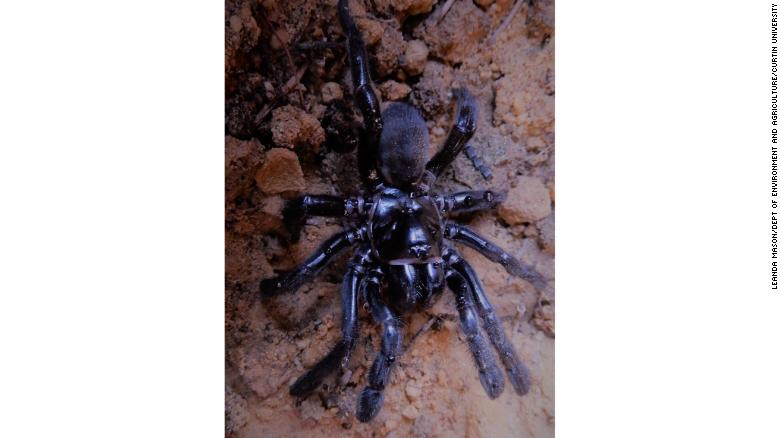
Number 16’s burrow lid was pierced by a mean parasitic wasp, whose sting later killed her.
The cause of its longevity
No. 16 lived in Western Australia, where trapdoor spiders were the subject of a decades-long study that began in 1974.
Thanks to the detailed and long-term research, scientists determined why No. 16 lived so long:
- It lived in uncleared, native bushland
Trapdoor spiders may look a bit intimidating but they pose no danger to humans. Their bites are nontoxic to humans and they are usually very timid.
She outlived the previous world record holder, a 28-year-old tarantula found in México.
(From: https://www.cnn.com/2018/04/30/world/worlds-oldest-spider-dies-at-age-43-trnd/index.html)
++++++++++
Newly discovered millipede has 414 legs, 200 poison glands and 4 penises
A new species of millipede, discovered in a cave in California, joins the rarely-seen family of Illacme, known for having more legs than any other animal on the planet. The new creature, dubbed Illacme tobini, has been studied from a single male specimen and boasts a strange list of body parts, including 414 legs (four of which function as its penises), 200 poison glands that spray an unknown chemical, mysterious mouthparts and a body covered in hairs that secrete silk.
Not much is known about the Illacme family of millipedes. Until the discovery of tobini, the sole species was the Illacme plenipes, first described in 1928 then not seen again in the wild for another 80 years. Of the 17 specimens in collections around the world, one holds the record for the leggiest animal on Earth, with a total of 750 legs. Most of the plenipes specimens were found near San Juan Bautista in California, and their rarity makes the new discovery particularly exciting for diplopodologists – scientists who specialize in the study of millipedes.
“I never would have expected that a second species of the leggiest animal on the planet would be discovered in a cave 150 miles (240 km) away (from the plenipes site),” says Paul Marek of Virginia Tech, one of the researchers who described the new species.
Just one Illacme tobini specimen was found in a cave during an expedition to Sequoia National Park in 2006, despite thorough searching in the cave and surrounding areas for more of them. It was preserved in ethanol, dissected and had samples of its DNA extracted, and study of its anatomy found it to be a close relative of the plenipes, but a distinct species.
With a tally of 414 legs, this one specimen sounds far short of the record-holding 750, but it is about average for the better known Illacme species. The tobini‘s four penises are actually four of its legs, repurposed for reproduction, and the body is covered with tiny hairs that appear to secrete a silk-like substance. Further adding to the mystery, pores in its mouth seem to give off an unknown secretion, and each of its segments is adorned with a pair of glands that spray poison, although just what it sprays also hasn’t been identified.
Since only the one specimen has ever been found, the researchers can’t be sure how widespread the Illacme tobini is, but it likely has a pretty limited range. They conclude that the area should be explored and surveyed in more detail to paint a better picture.
The research was published in the journal Zoo Keys.
Source: Virginia Tech, via EurekAlert
++++++++++
It sports a green mohican, fleshy finger-like growths under its chin and can breathe through its genitals.
The Mary river turtle is one of the most striking creatures on the planet, and it is also one of the most endangered.
The 40cm long turtle, which is only found on the Mary river in Queensland, features in a new list of the most vulnerable reptile species compiled by the Zoological Society of London (ZSL).
Despite the turtle’s punk appearance – derived from vertical strands of algae that also grow on its body – its docile nature made it historically popular as a pet.
Gill-like organs within its cloaca – an orifice used by reptiles for excretion and mating – enable it to stay underwater for up to three days, but it was unable to hide from the pet collectors who raided its nests during the 1960s and 1970s.
The turtle is placed at 30th on ZSL’s Evolutionarily Distinct and Globally Endangered (Edge) list for reptiles. First established in 2007, Edge lists have previously been published for amphibians, birds, corals and mammals, helping guide conservation priorities for 100 most at-risk species. Each species is given a score which combines extinction risk with its evolutionary isolation or uniqueness, with the latest list supported by a study in the journal Plos One.
Top of the list is the Madagascar big-headed turtle, which has an Edge score higher than that of any other amphibian, bird or mammal, and is still taken for food and global trade.
Other unusual and endangered species include the Round Island keel-scaled boa from Mauritius, a snake which is the only terrestrial vertebrate known to have a hinged upper jaw; the minute leaf chameleon from Madagascar which is the size of a human thumbnail; and the gharial, a slender-snouted fish-eating freshwater crocodile. Less than 235 gharial survive in the rivers of northern India and Nepal.
Rikki Gumbs, co-ordinator of Edge reptiles, said: “Reptiles often receive the short end of the stick in conservation terms, compared with the likes of birds and mammals. However, the Edge reptiles list highlights just how unique, vulnerable and amazing these creatures really are.”
He added: “Just as with tigers, rhinos and elephants, it is vital we do our utmost to save these unique and too often overlooked animals. Many Edge reptiles are the sole survivors of ancient lineages, whose branches of the tree of life stretch back to the age of the dinosaurs. If we lose these species there will be nothing like them left on Earth.”
++++++++++
Squirrel With Injured Legs Gets Ingenious Prosthetic With Wheels
Alf is the little squirrel who can wheel himself around now.
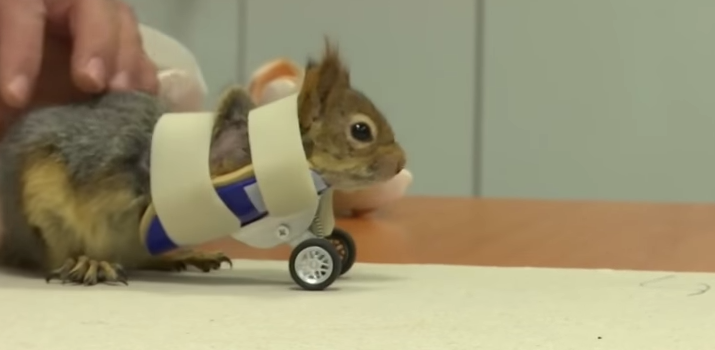
This February, Karamel the squirrel was caught in a trap set for wild animals in Turkey’s southeastern province of Batman. Luckily for the squirrel, 19-year old Rüzgar Alkan walked by and noticed the injured animal. Alkan told the Turkish Hürriyet at the time:
“I found it in the woods. It couldn’t move. I had to do something so I took it to a veterinarian in the center of Batman, using what little money I had. The vet said the situation was serious and an expert vet should check it, so we started researching what we could do.”
Eventually Alkan found computer engineer Tayfun Demir, a squirrel breeder. Working as part of a group alongside orthopedists Mustafa Gültekin and Tolgay Şatana as well as physical therapist Eylem Küçük, Alkan took the bus to Istanbul where he handed the squirrel off to Demir. Alf, as Alkan named the squirrel, was in surgery for six hours at before emerging with this prosthetic. Platinum plates were were fixed in its four broken legs.
“Squirrels are considered like a species of mouse. So they are killed immediately wherever they are seen. But they are living creatures that can live in harmony with people. Awareness needs to be created in Turkey in this regard,” said Demir after Alf’s surgery.
While it’s undoubtedly good news for squirrels everywhere, once they get their hands on bionic power there’s no telling what else they could ruin.
See more information at: https://www.popularmechanics.com/science/animals/a19724248/squirrel-with-injured-legs-gets-ingenious-prosthetic-with-wheels/
++++++++++
Canary
The bird is named after the Canary Islands, not the other way around. The islands’ name is derived from the Latin name canariae insulae (“islands of dogs”) used by Arnobius, referring to the large dogs kept by the inhabitants of the islands. A legend of the islands, however, states that it was the conquistadors who named the islands after a fierce tribe inhabiting the largest island of the group, known as the ‘Canarii’. The color canary yellow is in turn named after the yellow domestic canary, produced by a mutation which suppressed the melanins of the original dull-greenish wild Atlantic canary color.
(For more information see: https://en.wikipedia.org/wiki/Atlantic_canary)
Etymology
The name Islas Canarias is likely derived from the Latin name Canariae Insulae, meaning “Islands of the Dogs”, a name that was applied only to Gran Canaria. According to the historian Pliny the Elder, the Mauretanian king Juba II named the island Canaria because it contained “vast multitudes of dogs of very large size”.
Another speculation is that the so-called dogs were actually a species of monk seal (canis marinus or “sea dog” was a Latin term for “seal”), critically endangered and no longer present in the Canary Islands. The dense population of seals may have been the characteristic that most struck the few ancient Romans who established contact with these islands by sea.
Alternatively, it is said that the original inhabitants of the island, Guanches, used to worship dogs, mummified them and treated dogs generally as holy animals. The ancient Greeks also knew about a people, living far to the west, who are the “dog-headed ones”, who worshipped dogs on an island. Some hypothesize that the Canary Islands dog-worship and the ancient Egyptian cult of the dog-headed god, Anubis are closely connected but there is no explanation given as to which one was first.
Other theories speculate that the name comes from the Nukkari Berber tribe living in the Moroccan Atlas, named in Roman sources as Canarii, though Pliny again mentions the relation of this term with dogs.

The connection to dogs is retained in their depiction on the islands’ coat-of-arms (shown above).
It is considered that the aborigines of Gran Canaria called themselves “Canarii”. It is possible that after being conquered, this name was used in plural in Spanish, i.e., as to refer to all of the islands as the Canarii-as.
What is certain is that the name of the islands does not derive from the canary bird; rather, the birds are named after the islands.
(For more information see: https://en.wikipedia.org/wiki/Canary_Islands)
++++++++++
Organic Consumers Association
View This Email On the Web
Sign up Today! GMO Animals Should Be Regulated!
GMO Animals? image of a piglet with its nose in the air
If you think genetically modified salmon is a bad idea, wait ‘til you hear what kind of GMO animals Recombinetics, Inc., the “Monsanto of the genetically modified animal industry,” wants to unleash on the market.
Among other things, Recombinetics wants to genetically engineer pigs specifically to withstand a miserable life in factory farms. Not only that, but the St. Paul, Minn.-based biotech company wants to keep the U.S. Food & Drug Administration (FDA) from having anything to do with regulating GMO pigs, or any other GMO animals that could end up in the U.S. food supply.
TAKE ACTION: Tell the U.S. Department of Agriculture (USDA): Genetically modified animals need to be thoroughly safety tested by the FDA!
Recombinetics president & CEO Tammy Lee Stanock recently published an opinion piece that argued for ending FDA oversight of genetically modified animals in favor of “putting the USDA exclusively in charge of regulating all food animals.”
The advantage for Recombinetics is obvious. The FDA uses its regulations for animal drugs to review the safety of genetically modified food animals, such as GMO salmon. But the U.S. Department of Agriculture (USDA) has no process whatsoever for evaluating the safety of animals created through novel technologies, including the gene editing technology used by Recombinetics.
If the company’s plan succeeds, this would be the most drastic deregulation of biotechnology to date—and gene editing is just too risky to deregulate.
The authors of a recent study published in Nature Methods, “Unexpected mutations after CRISPR-Case editing in vivo,” found that gene-editing technology can introduce hundreds of unintended mutations into the gene-edited animal’s genome.
Mutations in certain genes can lead to cancer in the animal. And there’s been no testing done to determine the impact on human health of eating animals with these mutations.
The only way to adequately review the safety of an animal that results from the use of a CRISPR technology, one of the technologies used by Recombinetics, is to sequence the whole genome of a gene-edited animal and compare it with a non-edited control. This is what the FDA should require of companies like Recombinetics—before their products enter the food supply.
TAKE ACTION: Tell the USDA: Genetically modified animals need to be thoroughly safety tested by the FDA!
Thanks!
Alexis for the OCA team
P.S. To avoid GMOs, including Recombinetics gene-edited animals, buy USDA Organic!
Connect With OCA:
Like OCA on Facebook
Follow OCA on Twitter
Follow OCA on Pinterest
Follow OCA on YouTube
Join our Mobile Network: text ‘JoinOCA’ to 97779
The Organic Consumers Association (OCA) is a 501(c)3 nonprofit organization campaigning for health, justice, peace, sustainability and democracy. Donations to the OCA are tax-deductible to the fullest extent of the law.
6771 South Silver Hill Drive
Finland, MN 55603
Phone: 218-226-4164
Fax: 218-353-7652
Privacy Policy
empowered by Salsa
++++++++++
Dogs, Dogs, Dogs…!
The Most Affectionate Creature In The World Is a Wet Dog.
Virus-free. www.avast.com +++++++++++
Scientist unearths ancient camel fossils in Canadian Arctic
February 7, 2018Scientist unearths ancient camel fossils in Canadian Arctic
A Canadian scientist has discovered bone fragments which confirm that the ancestors of modern camels once roamed the country’s Arctic region.
Disclaimer: The BBC is not responsible for the content of this email, and anything written in this email does not necessarily reflect the BBC’s views or opinions. Please note that neither the email address nor name of the sender have been verified.
Wild Mustangs of Placitas (click on words)

















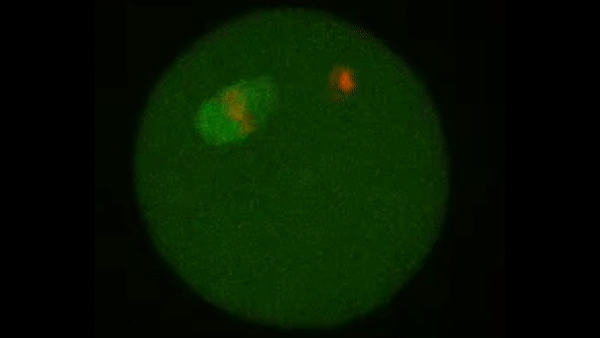


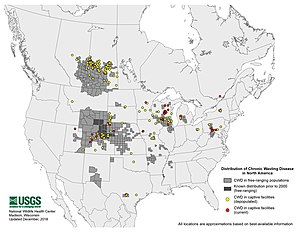

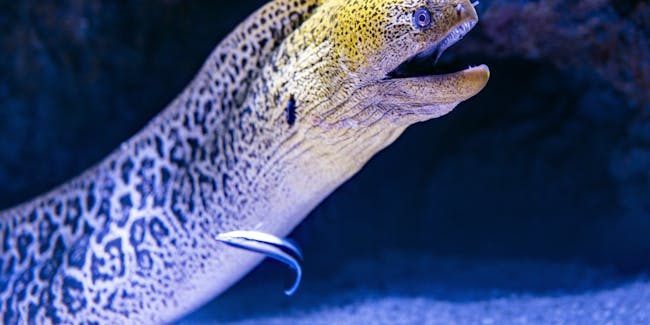

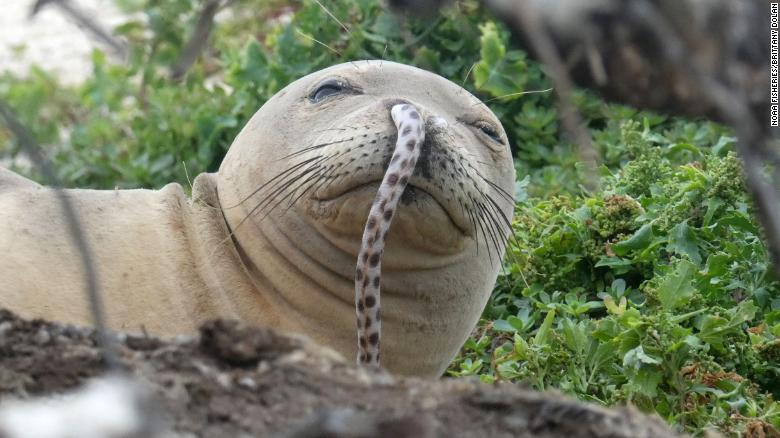

















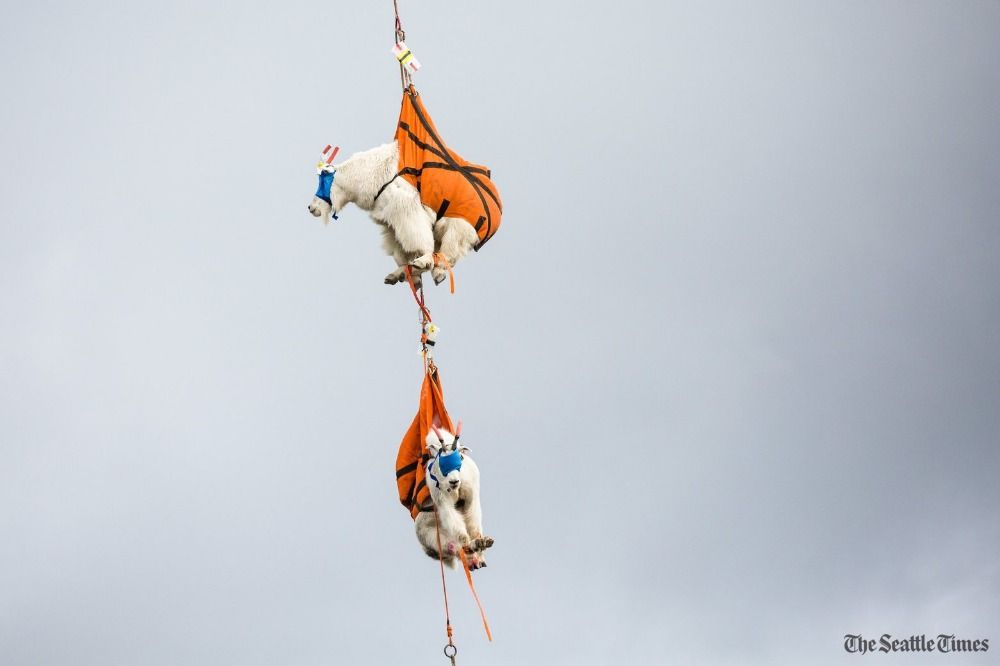
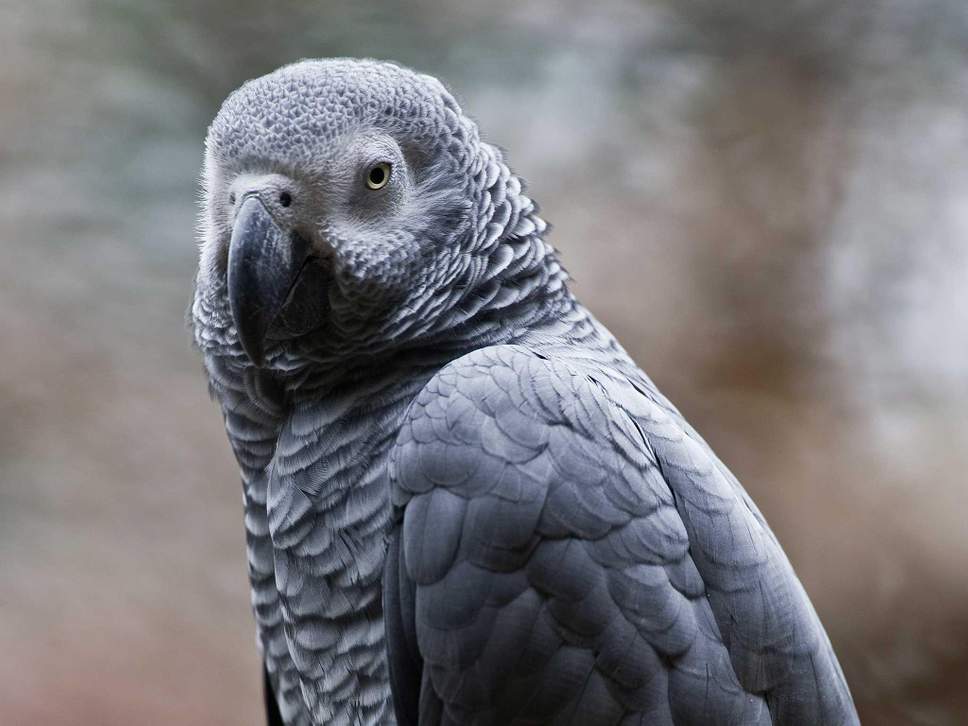









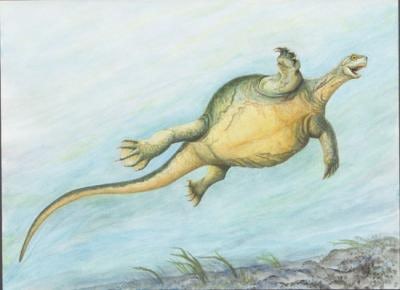






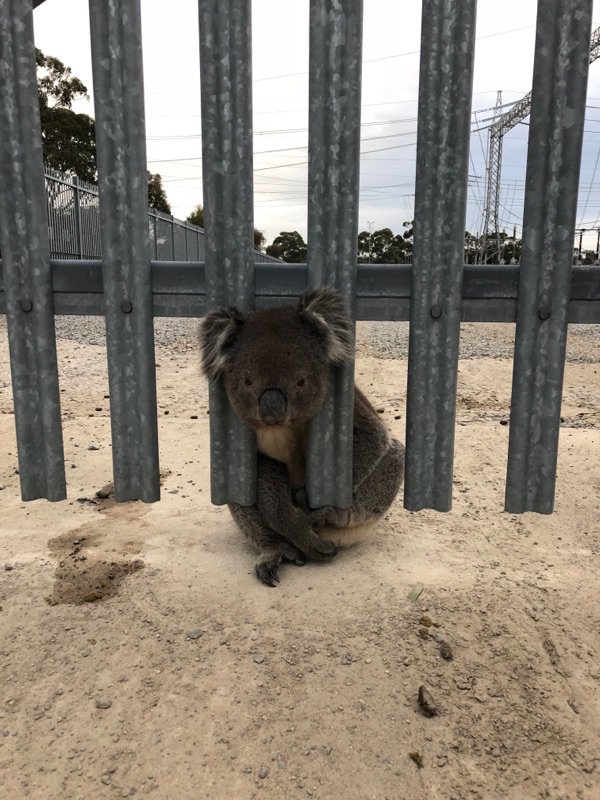
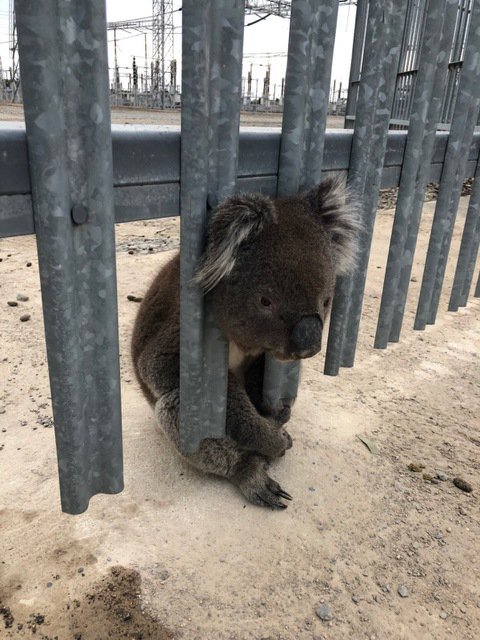
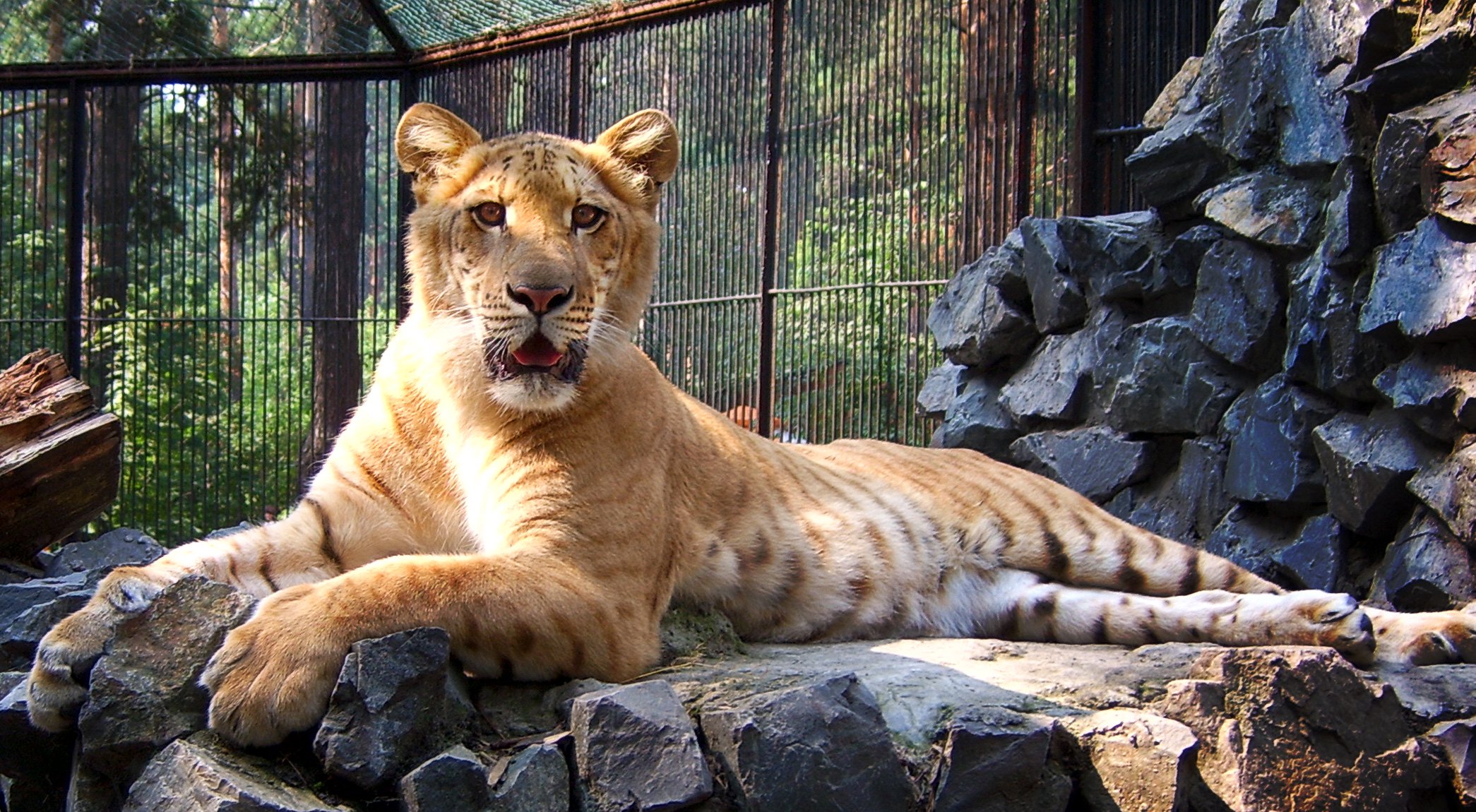

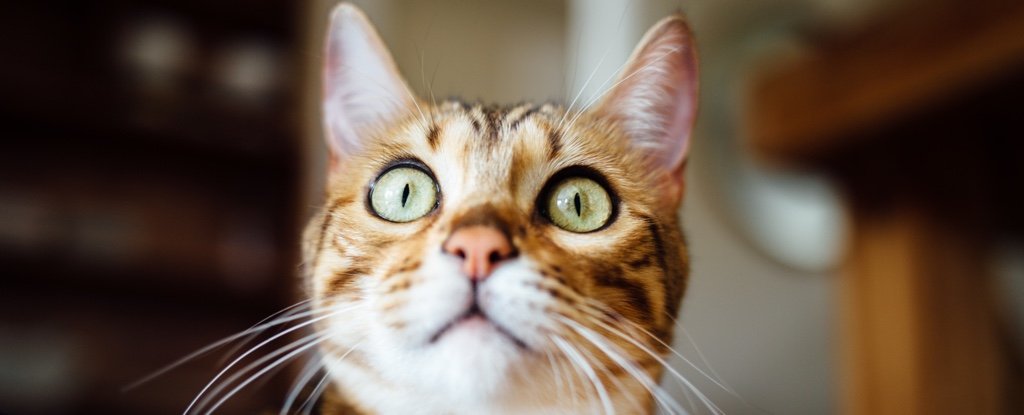















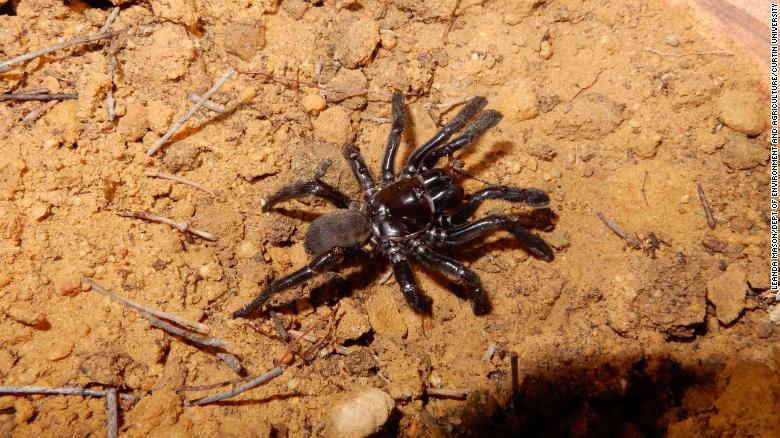

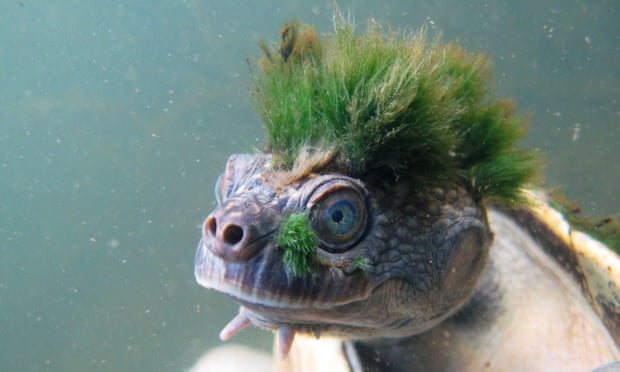





















![]](https://www.shangralafamilyfun.com/gala-e/dogsmell.gif)